






























The 2022 Rose Parade held on New Year’s Day in Pasadena, California, marked the 42nd consecutive year of Rotary’s participation. The theme for the Rotary Float was Changing lives through education
RI President Shekhar Mehta and Rashi, seated on the float, were seen waving out to hundreds of spectators lined up on either side of the parade path. “This will help build awareness about Rotary and fulfil our mission to grow Rotary. Just think, every person who sees our float is another potential member,” said Mehta in his message.
The float featured a 16-ft-tall owl, surrounded by books, sporting reading spectacles and holding an apple/globe, to symbolise the importance of education throughout the world, and Rotary’s determination to make it available to everyone everywhere.
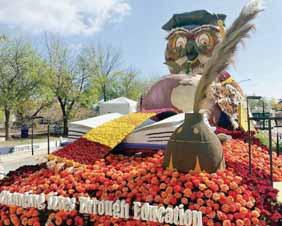



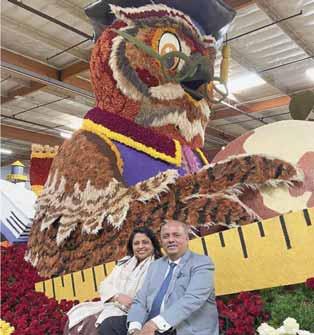


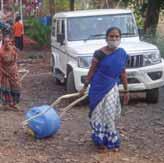



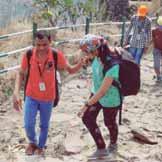

12 Rourkela Rotarians extend the gift of hand
RCs Rourkela Royal and Rourkela Queens help 110 people get prosthetic functional hands through an ambitious LN4
20 Waterwheels to the rescue of women in rural Maharashtra, Gujarat
Women in drought-prone regions no longer need to carry pots of water on their head, thanks to the waterwheels gifted
38 RC Delhi Ananta launches a `8.5 crore project
The club has set up a mega hospital, training and skilling project
44 TRF grants: bane or boon
One of the sessions at the Mahabs 21 zone institute cleared
52 Focus on mangrove plantations and waste management
The environment sustainability session at the zone institute discussed the importance of preserving mangroves and waste
56 Uttarakhand school back on track with Rotary gifts
RC Rudrapur surprised children with school essentials after
72 A Rotaract club for blind students in Pune
RC Pune East has sponsored RAC Divya Zhep with 26
74 What you wear matters
Our Go Green column highlights the link between mindless purchase of clothes and global carbon emission from textile

On the cover: A boy practises writing with his newly fitted LN4 prosthetic arm at a fitment camp organised by RCs Rourkela

Mahabs institute comes alive in Rotary News
Though I did not attend the Mahabs institute, the coverage of the event is excellent with eye-catching photos. It was like attending the institute sitting at home. The In Brief column is an example of good coverage of interesting news, sports snippets and events that induce a positive feeling. RC Amravati Midtown, providing a palliative care to the differently-abled and helping them to transition from mental illness to mental wellness is a great project. Kudos for making this magazine one of the best from the Rotary stable.
Dr Basava Varahalu RC Razole — D 3020
Colourful pictures and wide coverage of the Mahabs zone institute make the January issue an attractive and adorable package. It is heartening to read that in spite of the third wave of Covid and unprecedented rains and floods, over 700 delegates attended the gala event. Kudos to Mahabs chair PDG M Muruganandam and his team for the meticulous planning and hard work in organising the mega event and RID AS Venkatesh for his leadership as convener.
Best article ever in Rotary News
The article on the Milkman of India, Verghese Kurien, in the December issue is the most interesting article I’ve ever come across in Rotary News. Although I have read about Kurien and his achievements elsewhere,
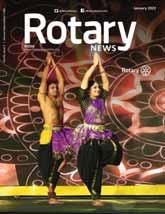
After going through the coverage of the event by the Rotary News team, we felt as though we had attended the entire event. RI President Shekhar Mehta rightly says there is no other place in the Rotary world where so much good work is being done as in our region. The way the institute articles and features were presented will make Rotarians proud and further commited to take Rotary forward.
R Srinivasan, RC Madurai Midtown — D 3000
The cover page photo of cultural performance at the institute was excellent. RI President Mehta’s message, Use your vocation to change lives, is important.
your article has brought out the other side of the gentleman I didn’t know so far. His quick-wittedness, care for public money, tough stand against the bureaucrats and compassion towards the farmers helped him safeguard one of the most premier cooperatives of our nation.
Editor’s note, A zone institute in challenging times , was interesting. Trustee Chair John Germ’s message on the global polio eradication initiative was superb. Rasheeda’s article, Addressing challenges in Rotary was magnificent; and Kiran’s article, DEI principles must for Rotary to grow, was fantastic.
Daniel Chittilappilly RC Kaloor — D 3201
I love the way in which this entire article Addressing challenges in Rotary has been written. It shows a high level of integrity to publish the content in that form and bring the information of that session candidly to the readers. The top-bottom approach is appreciated. If the clubs start to focus on the community instead of targets and members, then the probability of members enjoying Rotary will rise considerably.
Vivek Khandelwal RC Deonar — D 3141
The cover picture is attractive. RI President Mehta’s message asking Rotarians to use their vocations to serve to change lives, is motivating.
Thank you for bringing out the story of a great leader who cared for the community and brought cheers to millions of families in India. I was happy to share it with my entire family, from my father to grandchildren.
K Ravindrakumar
RC Karur — D 3000
Election blues
R ID Mahesh Kotbagi’s column on elections in Rotary in the Jan issue should never have been published. Being instrumental in establishing Rotary News in 1982, I had great respect for it. But unfortunately, now I have lost it because
Glad to note the institute was held successfully. RID Mahesh Kotbagi’s message on elections in Rotary is an eye-opener. RID AS Venkatesh’s piece on ‘Let’s create history’ is noteworthy. TRF Trustee Chair explains well the importance of Rotary’s partnership with similar agencies. Was delighted to read about the outstanding work of Rotary in India over the last 10 years. Kapil Dev’s speech is eminently readable. The Q&A session in the article Addressing challenges in Rotary, as reported by the editor is humorous, informative and enjoyable.
The photos and description of Mahabs 21 are excellent. Articles like Rotaractors air their thoughts on policy changes, DEI principles must for Rotary to grow, Glimpses of District 3030, and the obit piece He lifted Rotary to Himalayan heights by PRIP Rajendra Saboo are interesting. The health feature on collaborative living is great. The December issue, last of 2021, had great content.
Philip Mulappone MT RC Trivandrum — D 3211
such content slights the intelligence of Rotarians. What courage and hyocricy to write like this!
Sajjan Goenka RC Bombay West — D 3141
It was assuring to read RID Kotbagi’s message on elections. I have similar thoughts but did not voice them due to long-held traditions in Rotary. I feel that
elections should be akin to the American presidential elections. All contestants should have an open debate and every Rotarian, who has no dues pending, should have a vote. These are radical ideas but maybe these can be considered and taken forward.
Anand K Sharma RC Calcutta Park Point — D 3291
Wehave to reflect upon the reason why such a senior leader like RI Director Mahesh Kotbagi had to express his concern over elections in Rotary through his column. If Rotary has fallen from its high standards, it is because some leaders push membership growth and their favourites to occupy leadership positions in clubs. As a result, some people without ethics get these positions. It is the duty of everyone, not only senior leaders, to stem this rot, or else Rotary will lose its reputation.
Arvind Dudawat RC Gwalior — D 3053
Withreference to the article Prosthetic limb fitment camp in Kolkata, it may be noted that I am one of the oldest members of the Mahavir Seva Sadan which has fitted artificial limbs on over three lakh beneficiaries since 1986. Rotary clubs are one of the major contributors to this humanitarian service.
Piyush Doshi
RC Belur — D 3291
The Jan issue with diverse articles and features on the Mahabs institute offers a window on Rotary’s multifaceted work
in our zones. But what really stood out was a wonderful story on Combating cancer with a humane touch.
Thanks for publishing the commendable project of RC Madras Midtown. I have referred patients from poor background for financial help and the most impressive part of the support is the speed with which they respond to any request. The trustees talk to the patients or the caretaker and apart from giving money they show empathy and concern for the patients and the families, which boosts their confidence. I have seen this personally. The icing on the cake is that they are doing this for 25 years! I wish them many more years of this wonderful service.
Nikhil Singhi
RC Chennai Galaxy — D 3232
We welcome your feedback. Write to the Editor: rotarynews@rosaonline.org; rushbhagat@gmail.com. Mail your project details, along with hi-res photos, to rotarynewsmagazine@gmail.com.
Messages on your club/district projects, information and links on zoom meetings/webinar should be sent only by e-mail to the Editor at rushbhagat@gmail.com or rotarynewsmagazine@gmail.com. WHATSAPP MESSAGES WILL NOT BE ENTERTAINED. Click on Rotary News Plus on our website www.rotarynewsonline.org to readabout more Rotary projects.
Greetings, dear changemakers of Rotary,
At the start of the Rotary year, I challenged every club to plan and host at least one practical and action-oriented Rotary Day of Service. The event should address a challenge your community is facing that fits into one or more of Rotary’s areas of focus and should bring together volunteers from within and outside of Rotary.

Rotary Days of Service can motivate Rotary, Rotaract and Interact clubs to plan innovative and impactful projects. They can showcase your work as people of action and introduce prospective members to your club.
I’ve been inspired by your response so far, and I want to share with you just one project that has captured my imagination.
India is home to an estimated 74 million people with diabetes, a disease that is a leading cause of death. Furthermore, about 50 per cent of those people remain undiagnosed.
The camp was spread across more than 10,000 sites in India, with more than 2,000 Rotary and Rotaract clubs participating in the effort. More than one million blood-sugar tests were conducted in a day, an accomplishment recognised by the Asia Book of Records. But more important than breaking a record is the fact that tens of thousands of people learned that they may be living with diabetes. They can now be treated for the condition, and they also have been made aware that they should take extra measures to shield themselves from Covid-19 and scores of other diseases that are caused or worsened by diabetes.

I am also happy that the Each One, Bring One ethos is bringing fruitful results. Let us ensure that all club members introduce at least one person to Rotary, and that we then all work to engage new members and keep them in our clubs.
In whatever we do, remember that we must push ourselves to grow more, do more as we Serve to Change Lives.

Rotary, together with the Research Society for the Study of Diabetes in India, saw the urgent need to diagnose, track, and treat people who have diabetes. Working together and with other organisations, we hosted a nationwide blood glucose testing camp on Sep 29 which is World Heart Day.

This month, on Feb 23, the anniversary of Rotary, let us celebrate with more service days, showcasing Rotary’s work in our areas of focus. I look forward to hearing about your Rotary Days of Service. Please share your projects on Rotary Showcase, or browse that webpage to find inspiration and project partners. In particular, I encourage you to execute projects that focus on empowering girls, as they have been disproportionately affected by the pandemic. The Empowering Girls initiative is resonating very well with members of Rotary as well as with non-Rotarians. The governments and NGOs in various countries are appreciating this meaningful effort. Let us keep focusing on it.


Shekhar Mehta President, Rotary International
Sh President hekhar Mehta , Rotary Internatiional





As Jaishree’s article in this issue (Pg 20) illustrates, a simple, mechanical device like the waterwheel that some Rotary and Inner Wheels clubs in Mumbai have been giving to poor rural women in some villages of Maharashtra and Gujarat is proving to be a great boon to women. An innovative, semi-mechanical solution to transport water from the village well or community tap to their homes, the waterwheel is a cylindrical, high-density plastic drum that can hold about 45–50 litres of water. The sturdy container is fitted with a strong metal handle, which allows it to be rolled down any path or rough terrain like a trolley. It eliminates the physical strain of carrying pots on the head, or waist, and as the capacity is 45–50 litres, the number of trips can also be reduced.
We know that lakhs of Indian women not only in rural India, but also towns and cities, have to grapple with the task of carrying at least a few pots of water on their heads, because fetching water for household chores is considered a “woman’s job” in our communities. In drought-prone areas of Maharashtra, Rajasthan, Madhya Pradesh and Gujarat, tens of thousands of women walk a distance of 2–4 km with water pots on their heads for a couple of km. What this chore, day after day, month after month, year after year, does to their knees, back and shoulders can only be imagined.
But this novel device, which takes away the drudgery of carrying water over the head has caught the fancy of not only children, both boys and girls, who readily volunteer to roll the water cylinder home, but also the men, who are volunteering to take on the task of bringing water home 3–4 days a week, freeing the women to concentrate on chores which are less taxing physically.
The waterwheel was developed thanks to the initiative of Cynthia Koenig, founder and chief executive of Wello, an American social enterprise working to explore ways to deliver clean water in developing countries like India and Africa. She first came on an exploratory trip to Rajasthan in 2010, and discussed with villagers the option of rolling water instead of carrying it. Expectedly, the women loved the idea and she returned a year later, and worked in close collaboration with these villagers. After several trips and experiments with water drums/cylinders of various capacities such as 10, 20, 30 and 50 litres, she zeroed in on cylinders that could carry 45–50 litres of water. Cynthia was pleasantly surprised to find the waterwheel’s popularity among the men, and was happy that in many village homes, the men happily shared this chore with their wives!
Apparently, this device is also popular in some pockets in Africa, where it is known as the hippo wheel and can carry water up to 100 litres. In India a commercial plastic product manufacturer, Nilkamal, makes these waterwheels under the Wello brand and Rotary gets it at a discounted price of `2,100 and distributes it at only ` 100 to the women. Amrish Daftary, member of RC Bombay Hanging Garden, RID 3141, tells Rotary News that from March 2016, his team has distributed over 4,000 waterwheels in various villages in Gujarat and Maharashtra. With RI President Shekhar Mehta asking clubs to do bigger and bolder projects, and a single, young Rotary club — RC Delhi Ananta — launching a project of over `8.5 crore, (detailed in this issue), the project to distribute waterwheels to poor, rural women needs much more patronage from the over 4,000 Rotary clubs in India.
Rasheeda Bhagat
RID 2981
RID 2982
RID 3000
RID 3011
RID 3012
RID 3020
RID 3030
RID 3040
RID 3053
RID 3054
RID 3060
RID 3070
RID 3080
RID 3090
RID 3100
RID 3110
RID 3120
RID 3131
RID 3132
RID 3141
RID 3142
RID 3150
RID 3160
RID 3170
RID 3181
RID 3182
RID 3190
RID 3201
RID 3203
RID 3204
RID 3211
RID 3212
RID 3231
RID 3232
RID 3240
RID 3250
RID 3261
RID 3262
RID 3291
S Balaji
K Sundharalingam
R Jeyakkan
Anup Mittal
Ashok Aggarwal
Rama Rao M
Ramesh Vishwanath Meher
Col Mahendra Mishra
Sanjay Malviya
Ashok K Mangal
Santosh Pradhan
Dr Upinder Singh Ghai
Ajay Madan
Parveen Jindal
Rajiv Singhal
Mukesh Singhal
Samar Raj Garg
Pankaj Arun Shah
Dr Omprakash B Motipawale
Rajendra Agarwal
Dr Mayuresh Warke
K Prabhakar
Thirupathi Naidu V
Gaurishkumar Manohar Dhond
A R Ravindra Bhat
Ramachandra Murthy M G
Fazal Mahmood
Rajasekhar Srinivasan
Shanmugasundaram K
Dr Rajesh Subash
Srinivasan K
Jacintha Dharma
Nirmal Raghavan W M
Sridhar J
Dr Mohan Shyam Konwar
Pratim Banerjee
Sunil Phatak
Santanu Kumar Pani
Prabir Chatterjee
Printed by PT Prabhakar at Rasi Graphics Pvt Ltd, 40, Peters Road, Royapettah, Chennai - 600 014, India, and published byPTPrabhakaronbehalfofRotaryNews Trust from Dugar Towers, 3rd Flr, 34, MarshallsRoad,Egmore,Chennai600008.
Editor: Rasheeda Bhagat.
The views expressed by contributors are not necessarily those of the Editor or Trustees of Rotary News Trust (RNT) or Rotary International (RI). No liability can be accepted for any loss arising from editorial or advertisement content. Contributions — original content — are welcome but the Editor reserves the right to edit for clarity or length. Content can be reproduced with permission and attributed to RNT
Empowering women is key to building a future that we all want. She is the full circle and within her is the power to create, nurture and transform.
As is true throughout the world, the key to propelling economic progress, social transformation and general development is women’s empowerment. If women become stronger, then, so will children and families. It is imperative to support them by establishing a fair and equal market with equal opportunities.
Apart from Rotary clubs, there are many NGOs and government projects to support women, help them develop their skills and use them professionally to create a self-sustaining life for themselves and their families.
Women’s empowerment is intertwined with respect for her rights. Movements such as MeToo and Time’sUp have focused attention on violence and discrimination against women. Countries around the world are emphasising and focusing on women’s safety and giving them respect at the workplace. Creating forums addressing issues related to women must be prioritised and a team of legal and counselling professionals should be appointed for speeding up the justice process.
Along with the women’s literacy and education
programmes, teaching self-defence in schools can boost up the confidence and self-respect of girls, thus helping them take the right decisions when required.
As diseases prey on weak minds and malnourished bodies, emphasis on hygiene and proper nourishment must be emphasised. Menstural hygiene needs to be highlighted and information on menarche (onset of menstruation) must be widely spread in the agegroups concerned. Poor knowledge and understanding may lead to unsafe hygienic practises that increase the risk of reproductive and genito-urinary tract infections, leading to poor attendance, dropping out from schools and poor academic performance, resulting in a poor quality of life. Data shows that absenteeism in schools during the menstural cycle is high due to inadequate disposal mechanisms for sanitary napkins and even superstitious notions at home. Menstrual hygiene management must be accentuated and clean, hygienic disposables must be provided. Alongside, training for disposing used products must be prioritised to control spread of infections.

As they say: “Little girls with dreams become women with vision.”
Here’s to strong women! May we know them, be with them, raise them…



Dr Mahesh Kotbagi RI Director, 2021–23



here is an ancient saying that a flower shop doesn’t need to advertise. Also culturally most of us have grown up with the belief that the left hand shouldn’t know what the right hand is giving. As a result of such beliefs, we have been traditionally averse to publicising our service projects. While membership growth continues to be our topmost internal priority, there can be two different approaches to it. One is to push Rotary into the community and hope such methods will make a few join. The other is to publicise our work in the community in a positive manner and to such an extent that membership in Rotary becomes an aspirational goal for many. This strategy of pulling people to Rotary will ensure sustainable growth.
All the aggressive membership growth ideas over the years, though moderately successful, haven’t really produced the kind of sustainable result that one dreams of. If we continue to do the same thing, we continue to get the same results. Let us start working on a different strategy. The starting point of it should be to focus more on the public image of our organisation. For far too long our efforts at promoting public image have focused on Rotarians rather than the work done by them. Let our stories carry the testimonials of beneficiaries. Let us showcase the impact our service activities has had on the community
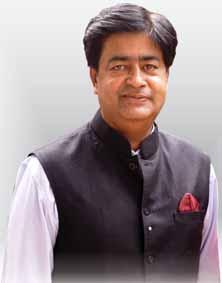
and the lives they have touched in a positive way.
There are so many impactful projects carried out by the clubs in our region. If only we present these in a manner that befits those projects, we can hope to pull more members into our fold. We need members. More importantly, we need the right members joining us for the right reasons. If each one of us decides to consciously become a brand ambassador of Rotary and promotes the organisation through various PR initiatives, our membership goal may no longer be a dream.
Let us talk Rotary! We owe it to our great organisation.

Shekhar Mehta RID 3291
Dr Mahesh KotbagiRID 3131
AS VenkateshRID 3232
Gulam A VahanvatyRID 3141
Rajendra K SabooRID 3080
Kalyan BanerjeeRID 3060
Panduranga Setty RID 3190
Ashok Mahajan RID 3141
P T Prabhakar RID 3232
Dr Manoj D DesaiRID 3060
C BaskerRID 3000
Dr Bharat PandyaRID 3141
Kamal SanghviRID 3250
Executive Committee Members (2021–22)
Gaurish DhondRID 3170
Anup Mittal RID 3011
Ramesh MeherRID 3030
V Thirupathi Naidu RID 3160
Jacintha Dharma RID 3212 Board of
Editor Rasheeda Bhagat
Deputy Editor
Jaishree Padmanabhan
Now share articles from rotarynewsonline.org on WhatsApp. Rotary News Trust 3rd Floor, Dugar Towers, 34 Marshalls Road, Egmore Chennai 600 008, India. Phone: 044 42145666 rotarynews@rosaonline.org www.rotarynewsonline.org
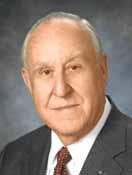
Ialways look forward to February, the month of Rotary’s anniversary, as a time to remember our history. What began as a small gathering in a Chicago office in 1905 soon transformed into a global movement — one that you and I are a part of today. February is also Peacebuilding and Conflict Prevention Month, when we celebrate a core Rotary concept: the pursuit of global peace and understanding.
Through our global and district grants, TRF is a force for peace — as are all of you who use those funds for projects. A grant that promotes literacy can lead to greater understanding and economic security in that community and beyond. This lays the foundation for peace. When communities aren’t fighting over scarce water resources, because they have a working pump system, they can instead pursue education. Promoting peace is interwoven in all that Rotary does. The work of actively building peace and understanding has been a hallmark of Rotary since its earliest days. But with the creation in 1999 of the Rotary Peace Centers we began a bold new chapter in this story. This year marks the 20th anniversary of the inaugural class of peace fellows; the innovative programme continues to merge a strong, academic understanding of the roots of conflict with practical tactics for solving real-world problems.
Despite the impacts of the Covid-19 pandemic, the Rotary Peace Centers were able to adapt, ensuring minimal disruptions to the programme. Now, students at our seven centres are resuming their normal activities. This includes young peacebuilders at our newest centre at Makerere University in Kampala, Uganda, who are preparing to apply their new knowledge and skills in a region that’s in need of peaceful solutions. The peace centre programme keeps growing. Our search committee is researching potential locations in the Middle East or North Africa to establish our eighth centre, with plans for its launch as soon as 2024. This is a significant step for Rotary’s efforts in global peace education, as we lay the groundwork for the next generation of fellows to pursue peacebuilding in that region. And we aren’t stopping there: Our goal is to open a Rotary Peace Center in Latin America by 2030.
In the last 117 years, Rotary has grown to become a global force for good — promoting peace and understanding in all of our endeavours. The staying power of Rotary, the Foundation, and our decades-long commitment to peace are things that are worth celebrating, supporting, and sustaining for the generations that will follow us.
John F Germ Foundation Trustee Chair
t is that time of the year again, a time of new hopes and new aspirations. In the Rotary world, January marks the beginning of the second half of the Rotary year. Has time gone by in a flash? Or has it moved slowly? In her famous novel The Colour Purple, Alice Walker comments on the duality of time: “Time moves slowly but passes quickly.” It is time then to take stock, to make every minute count, since so much remains to be done.

Just when we thought the situation was limping back to normalcy, a new mutation of Covid has once again disrupted life. Whilst many of us have adjusted to working from home, imagine the plight of workers in the travel and hospitality industries, many of whom were laid off and remain unemployed. Schools have been shut for almost two years now. An entire generation of schoolchildren is having to pay a terrible price because of the pandemic. Some children had to drop out of school because their parents have been rendered jobless; others suffer because the network connectivity for online education is not easily available; still others attend online classes but studies show that the “learning” is dismal.
The Rotary Foundation has many programmes that offer solutions to these problems. Clubs can discuss with the district leadership about the opportunities available.
Earlier, I spoke of the need for a half-yearly review. With respect to the Foundation, this review is an important exercise undertaken at the zonal level. Each of the four zones has a separate meeting and every DG makes a presentation of the district’s current TRF status and future plans. The zonal RRFC, EMGA, EPNC, ARRFCs, TRF staff from RISAO and the RI director concerned attend the meeting which is chaired by me as TRF Trustee. Teamwork is emphasised because we believe that “working together works”.
I urge every DG and club president to undertake this midyear review, not only of TRF contributions but also membership goals, service projects and pandemic related issues that have beleaguered the local community. Please do not delay this exercise because, as Brooke Davies says in the TV series One Tree Hill, “One day, you’re 17 and you’re planning for someday. And then quietly, without you ever really noticing, someday is today. And then someday is yesterday. And then it’s too late.”
Best wishes for a happy, healthy and peaceful 2022.

Gulam A Vahanvaty Trustee, The Rotary Foundation







Dear Readers
We, at Rotary News, have been bringing you the magazine without increasing the price from 2011. In fact, in 2014, the annual subscription was reduced from `480 to `420. As cost of paper, other inputs and administrative expenses are constantly rising, the RNT Board has decided to increase the subscription price by a mere `5 every month — from `35 to `40 per copy.
So the annual subscription dues for Rotary News (English, Hindi and Tamil) will go up from `420 — a figure several Rotarians disliked! — to `480 for every member, effective from July 2022.
The annual subscription for the E-version now goes up from `360 to `420 from July 2022.
We seek your cooperation and compliance.
Editor



Subscriptions can be made online


ubscriptions ns
Name Rotary News Trust Bank

HDFC Bank, Montieth Road Egmore, Chennai
SB A/c No 50100213133460
IFSC
HDFC0003820
After the transfer of funds, please share by email or WhatsApp the UTR number, club name, president/secretary’s name, amount and date of transfer.
Our email id rotarynews@rosaonline.org
WhatsApp 9840078074
The subscription form can be downloaded from https://rotarynewsonline.org/ wp-content/uploads/2022/01/SubscriptionForm-22-23.pdf

Rasheeda Bhagat
Sometime before the festival of Rakhi this year, Ajay Agarwal, past president of RC Rourkela Royal, RID 3261, while scanning through his Whatsapp messages was stuck by a particularly moving message. It contained the video of a Cadbury ad in which a little girl ties rakhi on the wrist of her little brother.
The only difference in this particular visual was that the little boy has experienced the thrill of his sister tying the thread of love around his wrist for the first time, because only recently, the child who had lost both his arms, had been fitted with
Sharad Sheth, member of RC Jamnagar (RID 3060), guiding a man to practise writing with his newly fitted LN4 arm.
a prosthetic hand, enabling his sister to tie the rakhi. What was more, the sensor fitted on the prosthetic hand, allowed him to feel the thrill of the sense of touch of the soft thread of the rakhi
Cadbury had tied up with Social Hardware, an organisation working for providing assistive devices and rehabilitation services to underprivileged communities, to develop a unique sensor-based prosthetic arm that enables the person to feel the sense of touch.

“Watching this video, I got excited as we know very well that when we suffer
a fractured arm, a frozen shoulder or are troubled by disabling pain, we get frustrated, irritated and start cursing our bad luck,” says Agarwal.
The Rotarian started thinking about the repercussions for people who have lost their hands due to either an illness, an accident or are born without them. “While we feel sympathy for those who have only stumps for hands or lost them altogether, we can never really imagine what a herculean task it must be for them to carry on their daily routine… something that we take for granted. This disability makes them dependent and affects the whole family.”
While researching a prosthetic hand, which can help an affected person return to a near-normal life, Agarwal came across the LN4 prosthetic hand, which is low-cost, light, durable, easy to fit and remove and functional.

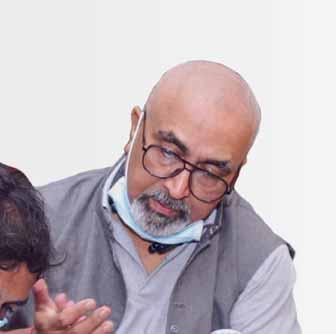
“I found that Ernie Meadows, who along with Michael Mendonca



and Maurice LeBlanc, an awardwinning mechanical engineer focused on assistive technology with special interest in upper limb prosthesis, worked tirelessly to develop a hand that was not too expensive but did not compromise on quality.”
‘LN4’ gets its name after Ernie’s daughter Ellen, who died in an automobile accident when she was only 18.
(Ernie then set up the ‘LN4 Hand Project’ to provide “everyone who requires a prosthetic hand to have one, regardless of their socioeconomic status or ability to pay. We manufacture a durable yet rudimentary prosthetic hand with no electric parts, and with the help of our partners, distribute it across the globe. We partner with organisations and individuals in developing countries who have less access to prosthetic limbs,” says their website.)
The Ellen Meadows Prosthetic Hand Foundation has been fitting hands since 2005 through Rotary across the world. The prosthetic hand, which costs around `25,000, is given totally free of cost to Rotary clubs to help people without hands. Of the 65,000-plus hands fitted across the world, about 24,000 have been gifted to India.
He soon identified Mohan Kumar, a member of RC Bangalore (RID 3190), the key person to get LN4 hands free from the US through this charitable organisation. Way back in 2008–09, the Rotary clubs of Sholapur, Pune, Jaipur and Jamnagar took up LN4 project proactively. Thanks to their initiative, interest and hard work, the LN4 prosthetic limb project has been done in every corner in India, says Agarwal.

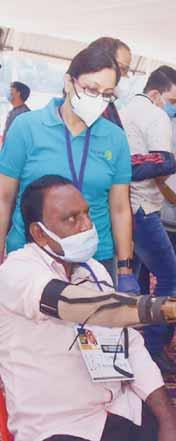
So his club, along with RC Rourkela Queens, which has been sponsored by their club, decided to organise an ambitious camp to fit LN4 hands on around 200 people in Rourkela. “The camp was actively supported by RC Jamnagar (RID 3060), which sent a couple of their members, who are experts in this work, to Rourkela to assist with the camp.” He clarifies that unlike the prosthetic hand fitted with a sensor in the Cadbury ad, the hands they fitted are basic versions minus the sensors.

Once a date — Nov 28 — was fixed, the first task was to identify the recipients. Information about the camp was circulated through various ways including getting help from Member of Parliament Juel Oram, and Rourkela MLA Sharada Prasad Nayak, President Rourkela Chamber of Commerce and Industry Praveen

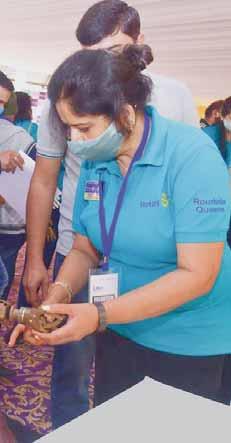
Garg, RID 3261 DG Sunil Phatak and several PDGs of the district to send out messages about the camp. “The media, both electronic and print, supported our publicity drive. Posters were put up, pamphlets were distributed and we sought the help of the local administration and the Regional Research and Rehabilitation Centre to get lists of disabled people who had lost their arms/hands. We wanted as many beneficiaries as possible to avail this first ever opportunity being offered in the state of Odisha,” says an excited Rashmi Agarwal, president of RC Rourkela Queens.
A core project team was formed and the Rotarians started reaching out to the beneficiaries. They were happy that most of the people who needed help were from the rural and tribal areas of Odisha. While the prosthetic
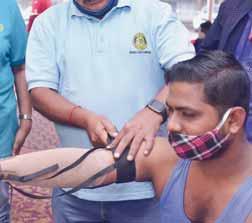
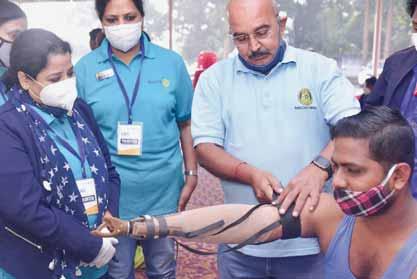
hands were given free of cost, they had to raise around `4.5 lakh to fund the camp, which included covering the cost of the visiting Rotarians from Jamnagar led by Rtn Sharad Sheth, giving breakfast, lunch and snacks to the recipients who had come from farflung areas early in the day.
Agarwal explains that for this device to be successful, recipients must have 14 cm of residual limb below the elbow to utilise this prosthetic device, to assure a strong fitting for the cuff. Additionally, there can be no remaining fingers, thumb, or wrist, as these will interfere with the cuff. Finally, the arm should be flexible and fully healed with no open sores or bandages to interfere with the attachment. “An innovative workaround” called an elbow extension, allows people who do not meet these criteria to get fitted with the LN4 hand. This elbow invention allows providing a prosthetic device to a greater range and number of upper limb amputees,” he says.
At the end of the day, even though the organisers were prepared

As for the causes, the Rotarians found these to be industrial accidents, electrocution and “some were born that way. A few did not have both hands while many had lost their major hand. Almost all of them were compelled to live a homebound life.”

to serve 200 people, only 110 persons could be fitted with the LN4 prosthetic hands, as some lacked the required criteria of the deformity which facilitates fitment. “For the first time, two clubs in Odisha have come together to do a project of this magnitude. The kind of media coverage we got will really enhance Rotary’s public image,” he beams.
Etching an image of the day when the camp was held, Ajay Agarwal, who is also the project chief, says, “On that pleasantly cold November winter morning, we were all geared up for our ‘Helping Hand’ project. The Jamnagar team led by Sharad Sheth, and the two local club members were there in their sea green Rotary t-shirts. The beneficiaries were checked, given masks and sanitisers, and after data completion, led to the LN4 hand fitting tables.” The Jamnagar members, expert in this task, began the job, and taught the Rourkela Rotarians the art of fitting prosthetic hands, and soon they too started fitting the hands.
At the camp, nurses from Jaypee Hospital, a reputed local hospital, along with the Jamnagar team and local Rotarians spent a lot of time with the beneficiaries to train them on how to perform simple dayto-day chores like peeling vegetables, rolling out a roti, holding a pen and so on. “Many of them signed on the
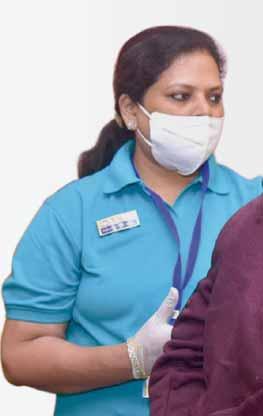



expression board with their newlyacquired hand and some even wrote words of gratitude. It was immensely satisfying to witness some of the beneficiaries eat breakfast and lunch with their LN4 hand,” he adds.
Perhaps the most heartening sight for the Rotarians was watching Gita, whose infant was being held by a companion when she came in for the fitment. “After she got the gift of a free LN4 hand, she cradled her own baby for the first time. It was a very emotional moment not just for her but all of us who witnessed this moving sight,” says Nigam Agarwal, president of RC Rourkela Royal.
Another moment of immense satisfaction came while watching a hockey player “who was so passionate about the game that he was playing
with one hand. He held the mop (kept for training) with both hands and was excited to finally hold it like a hockey stick with both hands. He now hopes to improve his game.”
But their work is not over with the fitment of the hands. “We have to now follow up on the people who have been fitted with these hands, about how they have adapted and are using them. Maybe after six months or one year we will organise another camp. We hope to make this a permanent project,” says Nigam, emphasising that the camp was much more than just fitting of prosthetic hands. It also involved training and counselling on how their lives would now change forever.




A man signing on the expression board with his newly-acquired hand at the camp.




A woman holds her baby for the first time after being fitted with a prosthetic arm at the camp.
By the time the dignitaries walked in for the inaugural session, quite a few beneficiaries were waiting with newly-fitted LN4 hands. Collector and district magistrate Nikhil Pawan Kalyan, ADM Rourkela, Commissioner of RMC Divya Jyoti Parida and SP, Rourkela, Mukesh Kumar Bhamoo attended the inaugural and appreciated the service extended to the community. Significantly, some of the beneficiaries had come from the neighbouring states of Jharkhand and Chhattisgarh.
The concluding session of the camp was attended by Rourkela MLA Nayak and DGN Manjeet Singh Arora.
The Rotarians truly got a taste of this year’s RI theme — serve to change lives. “We felt that till now we have been a part of so many projects done by our individual clubs but none was as life-changing as this one. We could feel that this project would have a long-lasting impact on the lives of beneficiaries and that made the camp so special,” Agarwal added.

One of the flagship projects conceived by RC Calcutta, which celebrated in 2019 not only the club’s centenary, but also 100 years of Rotary’s arrival in India, during its landmark year was the setting up of the Rotary Club of Calcutta Centennial Chintan Academy at the Takling Village in Baramangwa of Darjeeling, RI District 3240, which was inaugurated on Nov 25.
“We set it up at a cost of `50 lakh, (around $70,000) and the funds for this project were generated from members of the club, other philanthropic
donors as well as donor Rotary clubs in Germany, such as RCs Buchloe, Mainburg, Weissenhorn, Kaufbeuren and Viersen-Schwalm-Nette,” said RC Calcutta president Sujata Pyne.
Prior to the club’s intervention, the existing primary school, situated on the hilly terrain, on which over 40 students depended for some kind of learning, was a dilapidated “tatty structure, virtually with no room, walls or boundaries to stop children from falling over the cliffs.” As is the case in many remote parts of India, the “students had to walk 10 km up and down
the hills to reach the school, in which most of the students are first generation learners belonging to families of farmers, taxi drivers or mechanics,” she said.
For RC Calcutta’s centennial president Purnendu Roychoudhury, this was “a personal dream to help the remote communities of Lepcha and Gorkha children in Darjeeling district, who invariably and frequently drop out of schools because they are so difficult to reach in inclement weather conditions and have totally inadequate infrastructure and facilities,” he says.
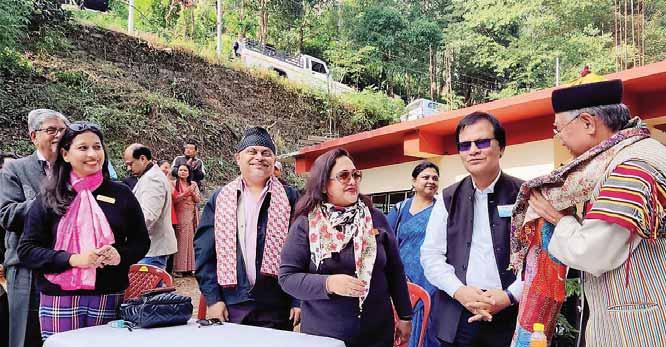

The spanking new school building is spread over an impressive 2,100 sq ft and replaces the dilapidated structure propped up on bamboo poles, thatched sheets and patched up with broken tin sheets, thatch, etc, leaving the children to the vagaries of nature’s elements. The school is now a proper,
colourful and cheerful concrete building, complete with classrooms with proper lighting and ventilation and where children now can pursue their education with dignity, seated on benches with proper desks.
Sujata adds that the inaugural event was colourful and impressive, attended
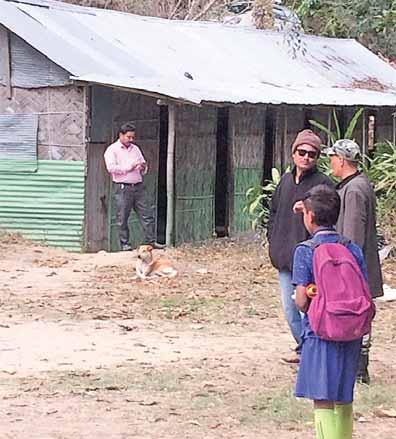
by two district governors — RID 3291 DG Prabir Chatterjee and RID 3240 DG Mohan Shyam Konwar. Along with Sujata, club secretary Sriranjani Joshi, treasurer Debjani Ghosh, past president Purnendu Roychoudhury and other club members attended the event. Others who participated included Lyangsong Tamsang Lepcha, chairman of West Bengal Lepcha Board and its secretary Reena Targain.
To take the education offered here to the next level, the Rotarians have also provided a computer section with five computers, which was also inaugurated. “There is a further plan to start a vocational training centre in this school within this Rotary year 2021–22. The chairman of the Lepcha Board has committed to provide teachers and faculty members for the school as well as books for the children free of cost while DG Chatterjee has promised to provide spectacles free of cost to all the children requiring them in all the 249 schools under the Lepcha Board,” said the RC Calcutta president.
Later, the same evening, a “a historic meeting” of three clubs was held at Darjeeling, attended by the two governors, office bearers of RC Calcutta, Roychoudhury and other members through a zoom link. Titled “the Umbilical Connect, it had participation
from RC Calcutta (102-year-old grandmother which had sponsored RC Darjeeling); RC Darjeeling (mother) and RC Darjeeling Himalayas (daughter). Both the governors — Chatterjee and Konwar — reiterated the need for the clubs and the two districts to work closely. Once this was done, Rotary could truly bring the world together, as getting funds from the German clubs for a school in Takling, a remote Darjeeling village, had shown, “to build a bright future for the Gorkha and Lepcha children who drop out of schools because of their inaccessibility and harsh weather conditions.”
“They also pointed out that anyway literacy is a thrust area of Rotary and congratulated the leadership of RC
I always do projects where the need is, and not just focus our service projects in a single geographical location.
Purnendhu Roychoudhury past president, RC Calcutta
Calcutta and centenary year president Purnendu Roychoudhury for the vision to go beyond RID 3291 and help people and communities in need,” added Sujata.
Roychoudhury later told Rotary News : “I always do projects where
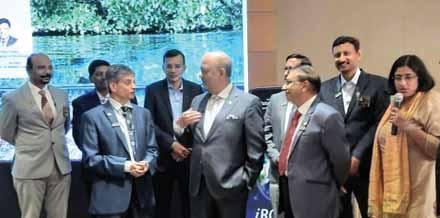
At an event on environment organised by Rotary Club of Bombay Pier, RID 3141, RI President Shekhar Mehta commended the development of Rotary South
Asia’s first club-specific carbon footprint calculator and urged all Rotarians to use it widely. Climate change is a serious issue and with the introduction of the new focus
the need is, and not just focus our service projects in a single geographical location. Now I am trying to adopt orphaned Kashmiri children with the help of two clubs in Kashmir. They will study and remain with their families, but Rotarians all over the world will fund the cost of their study and cost of living and the project will be monitored by us.”
Added club president Sujata: “It was so rewarding emotionally to witness the joy and hope amongst the budding young students, who displayed immense talent and potential through their interaction with us and performance, encouraging us, Rotarians, to strive and do much more through subsequent service projects.”
area in Rotary— supporting the Environment — such measures are vital to enable us to regulate human activities causing emissions.
The carbon footprint calculator was the initiative of Jaideep Malaviya, chairperson of Renewable Energy and Climate Change at RI District 3131. He is a past president of RC Pune Camp. “This calculates the amount of greenhouse gas emissions that occur as a result of the various activities involved in a typical club meeting or a project such as the number of vehicles used to travel, quantum of electricity used, food items served, etc,” he says. It can be accessed at https:// cfc-environment2122rid3131.vercel. app. The app was developed by Rtr Vedant Ghate, RAC Pune Mid East, and Arati Bhosale Ahiwale.
Malaviya says that after the necessary data requested is filled, the app pops up the carbon emissions that would have emanated for that particular Rotary activity. He was recently elected to the board of directors of the International Solar Energy Society (ISES) through a global voting process.
hen an anxious Zainab and Huzefa, parents of 10-month-old infant Haadiya, knocked on the doors of Rotary Club of Mumbai Parleshwar, RID 3141, to help treat their beloved child suffering from CHD on Aug 21, club president Unmesh and secretary Monika Tandon swiftly sprang into action. The baby was admitted at the Kokilaben Ambani Hospital two days later and the surgery was successfully performed. Today, thanks to Rotary’s life-saving intervention, little Haadiya is full of life and her parents are on top of the world with infinite joy.
Haadiya was born with a hole in the ventricular chamber of her heart and every time she gurgled or
cried, she would turn blue. She was under-weight and had difficulty in breathing and taking her feeds. Doctors recommended an emergency surgery to set right her heart condition. But the hitch was the hefty hospital cost — ` 2.35 lakh — which was unimaginable for the couple eking out a living from a plasticware and crockery stall in the Golibar Market in Santa Cruz.

“Enquiries for help led them to our club’s administrative director Sunita who passed on the request to Monika. From there on, with DG Rajendra Agarwal’s guidance, we took over and saw to it that the child is saved,” said club member PDG Subhash Kulkarni. While the district paid 50 per cent of
Little Haadiya with her mother Zainab. RC Mumbai Parleshwar secretary
Monika Tandon (R) and Rtn Sunita (L) are also present.
the hospital bills, the club members pitched in to settle the balance dues.
“It’s not just about paying the bills, but we were happy to provide timely assistance and personal care to the agitated parents and the ailing child. Monika was constantly in touch with the family until the child was discharged on Sep 3,” he added.
Haadiya’s mother Zainab summed up Rotary’s healing touch when she said, “The support given by all of you not only helped my baby but also gave us so much confidence, that we are not alone. Whenever we see Haadiya laugh, play or throw tantrums, we will think of Rotary with gratitude. Because Rotary gave our baby back to us.”



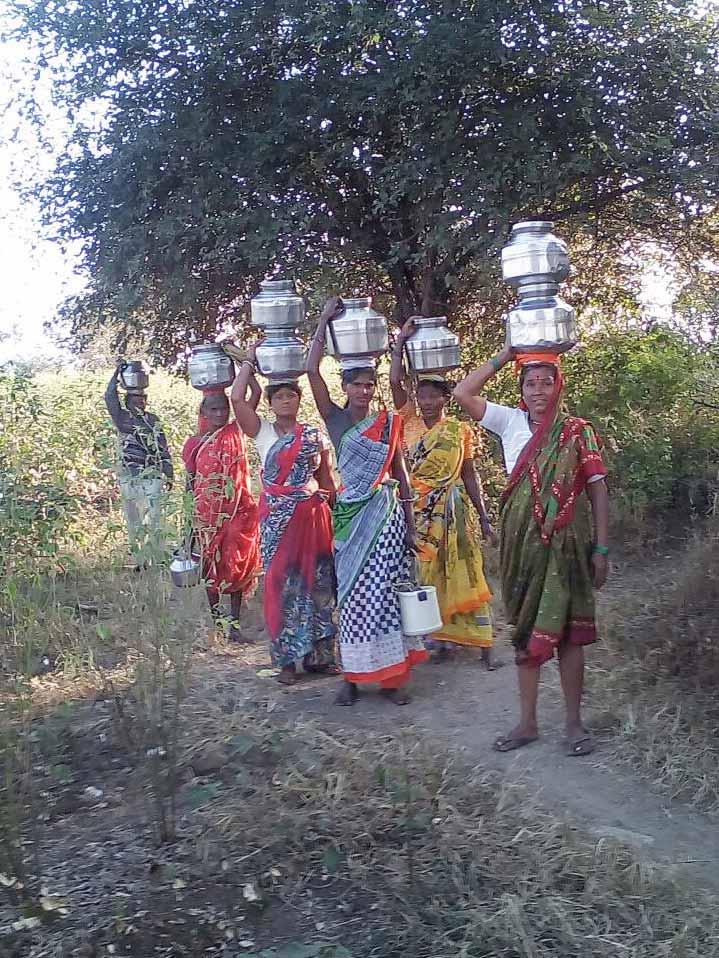
Jaishree
Innovative waterwheels are lifting the weight off the heads of hundreds of women in the drought-prone regions of Maharashtra and Gujarat. In one such initiative recently, six Rotary clubs and three Inner Wheel clubs of Mumbai, RID 3141, distributed 315 waterwheels — an ingenious solution to the burden of rural women carrying water over long distances.
Village women in India have to carry 1–3 pots over their heads depending on their household needs, and make 2–3
trips of 2–5 km in the heat or rain every day. They are prone to spine and back problems because they carry so much weight over their heads, says Amrish Daftary, Rotary Water Projects Avenue Chair, RID 3141.
The waterwheel makes it easy to fetch water from the nearest drinking water source. It is a cylindrical, high-density plastic drum that can hold over 45 litre of water and is fitted with a metal handle, which allows the user to roll it down the road like a trolley, without having to lift the weight. “It eliminates
Now this device is a godsend. I don’t have to go fetch water. There is a tug-of-war between my son and grandson to roll the container to get water.
the physical strain of carrying pots on the head, shoulders and waist, and with a 45-litre capacity, the number of trips can also be significantly reduced.”
Recalling his journey in this project, Daftary says that he came across this “unique product developed by an American woman Cynthia Koenig in 2016. She helped me source it from Nilkamal Plastics, the authorised manufacturers of the waterwheels.” The device is also popular in Africa, where it is called the ‘hippo wheel’, and has a 100-litre capacity.
A Rotarian since 1988, and a member of RC Bombay Hanging Garden, he is active in procuring and distributing the waterwheels to households in Digras, Karjat, Palghar and Akola taluks in Maharashtra, and in Gujarat. Since March 2016, his team has distributed over 4,000
waterwheels in various villages. Identifying the recipients is important, he says. Waterwheels are given only to those families who have no water source in their immediate vicinity and had to travel at least 1.5–2 km away from home to fetch water every day. “We identify such beneficiaries with the help of local NGOs and get the clubs to sponsor the waterwheels.” Each device costs around `2,200 plus GST. “But for Rotary it is a special rate of `2,100. We charge `100 from each recipient, for a sense of ownership, and if someone cannot afford it then we give it for free,” he says. Some clubs in New Jersey who were introduced to him by Cynthia had also contributed for this project earlier.
“Unlike the women, village men are reluctant to fetch water using pots. With the waterwheels, men, as well as children,
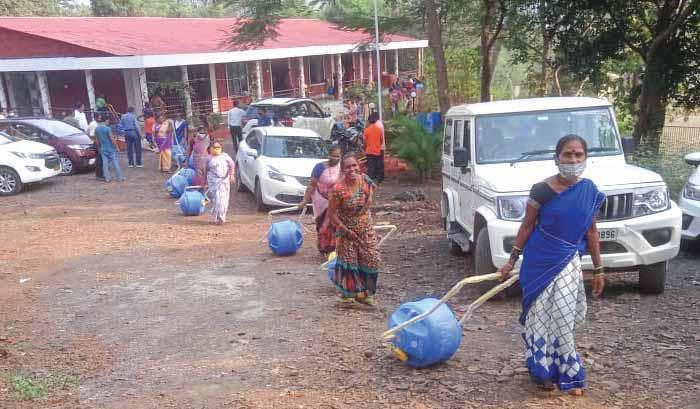

now pitch in to roll home the water needed for the family, making headloads a history for the women,” smiles Daftary.
Lakshmibai (65), a beneficiary from Palghar, is all smiles. “Earlier it used to be an arduous task when I had to carry three pots on my head and make as many trips daily to provide water for my family. I would have neck pain and feel tired. I had fallen down, or my pots dropped from my head several times. Now this device is a godsend. I don’t have to go fetch water. There is a tug-of-war between my son and grandson to roll the container to get water. They find it playful, like a pushcart toy. Even distance doesn’t matter now,” she says.
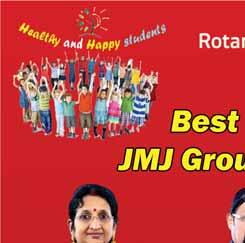
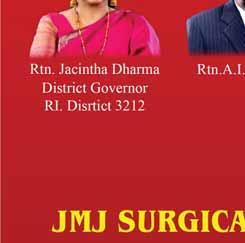









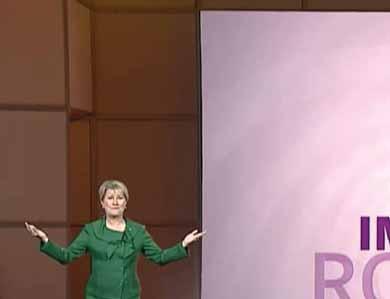
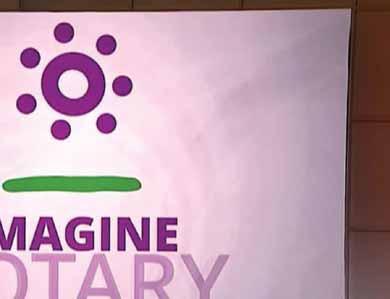

RIPE Jennifer Jones wants members to imagine the possibilities in the change they can make to transform the world.
Jennifer, a member of RC WindsorRoseland, Ontario, Canada, revealed the 2022-23 presidential theme, Imagine Rotary, as she urged people to dream big and harness their connections and the power of Rotary to turn those dreams into reality.
“Imagine a world that deserves our best where we get up each day knowing that we can make a difference,” she told the incoming district governors.
Jennifer, who will make history on July 1 by becoming Rotary’s first female president, gave a live online address to precede Rotary’s annual training event for district governors from around the world, the International Assembly. The assembly was
rescheduled because of the Covid-19 pandemic and will now be held virtually February 7–14.
She told the incoming governors about a chance she took when a member asked for assistance in getting a young peace activist out of Afghanistan during the US troop withdrawal last year.
At first unsure how she could help, she relied on “that certain Rotary magic” and contacted a former Rotary Peace Fellow she had met a few years earlier. Less than 24 hours later, the activist was on an evacuation list, and soon she was on her way to Europe.
Engaging members through meaningful responsibility
To better engage members, Rotary needs to “adapt and retool,” she said, using her hometown as an example. Windsor was once the automotive hub
of Canada. But after plant closings left thousands without work, the city needed to retool, in the same way an auto plant would, preparing for new parts or a new model. Now, Jennifer said, Windsor is a leader in agribusiness and medical and aerospace technology.
For Rotary, “finding the right ‘part’ to engage each member should be our core function. It comes down to the comfort and care of our members,” said the incoming president.
Engaging members is crucial to retaining members, she said, adding that we need to ask members what they want to get from Rotary and give them meaningful responsibilities.
“It is our offer of hands-on service, personal growth, leadership development and lifelong friendships that creates purpose and passion,” she said.
Embracing change also means embracing new club models, said Jennifer, as she asked the incoming governors to form at least two new innovative or cause-based clubs during their term. “Let’s make sure we engage our members so they love their clubs and their Rotary experience,” she added.
She also announced the appointment of a Rotaract member as a Rotary public image coordinator and said that she has included Rotaractors on several committees and will assign some Rotaractors as president’s representatives.
“We have been entrusted with leadership in our great organisation. Now it is up to us to be brave and intentional in our actions, and let others help us lead.”
The RIPE noted that Rotary has little time left to achieve the RI Board of
Imagine a world that deserves our best where we get up each day knowing that we can make a difference.
Jennifer Jones RI President-elect
Directors’ goal of having women make up 30 per cent of Rotary’s members by 2023. Rotary has achieved this in more than 110 countries, she said, but it has a long way to go. She pointed out that Rotaract has already achieved 50 per cent female members.
To raise Rotary’s profile, she plans to hold a global impact tour
that will include talking with leaders about working together to address the world’s most pressing challenges. “Rotary opens these doors and we need to harness our connections, to deepen these relationships and create new partnerships,” she said. “And the best part is, this can happen at every level of leadership.”
Jennifer closed her address by saying that although we all have dreams, acting on them is a choice we make. When an organisation like Rotary dreams about big things like ending polio and creating peace, it becomes our responsibility to make them happen. “You don’t imagine yesterday, you imagine tomorrow,” said Jennifer.
Rotary International
Convention 2022
The Houston food scene presents a classic conundrum for visitors: too many restaurants, too little time. While you’re in town for the 2022 Rotary International Convention, June 4–8, try a sampling of cuisines at these spots, all a short cab ride from downtown.
The Original Ninfa’s on Navigation offers quintessential Tex-Mex, a blend of Southern American and Mexican ingredients. Founded by “Mama” Ninfa Laurenzo in 1973, this Houston staple is credited with helping put fajitas on the national stage. Make sure to try their famous queso flameado and tacos al carbón, and cool off with an agua fresca.
Brennan’s of Houston serves up authentic creole cuisine and southern hospitality for a unique fine-dining

experience. Enjoy their signature turtle soup and locally sourced Matagorda Bay oysters. This sister restaurant to the famed Commander’s Palace in New Orleans also offers a jazz brunch on the weekend, perfect for beignets or shrimp and grits.
Nobie’s, which bills its fare as new American, offers farm-to-table dining in a hip, relaxed atmosphere. The eclectic
menu changes often, but you can expect innovative dishes like chickenfried quail or steak tartare topped with deviled-egg cream. Soak in the party vibe as you sip a craft cocktail or an offering from the extensive wine list. The classy-yet-casual Rosie Cannonball serves European comfort food with an Italian spin. Start with focaccia di Recco or blue crab carbonara, then dive into pizza, charred octopus, or other offerings from the wood-fired oven and grill. You’ll leave feeling as if you got a warm hug from the chicest Italian you’ll ever hope to meet.
Learn more and register at convention.rotary.org.
Source: Rotary

Aclub’s image is shaped by the action and projects of the club, and its involvement in the community. We at Rotary Club of Bharuch, RID 3060, would like to be known as people who are sensitive both about the environment and the need to remain fit and healthy through regular exercise,” says Rachana Poddar, club secretary.
To implant this image of the club on the local community, and create public awareness about two very important aspects of life, members of RC Bharuch, one of the oldest (78 years) and biggest clubs in RID 3060 with 145 members, organised a 10 km cyclothon in December to focus attention on health and fitness and the need to reduce our carbon imprint on this environment, says club president Dr Vikram Premkumar. Being a medical doctor himself, he felt that during his year health awareness should get priority in the club’s projects.

Apart from club members, Rotaractors and Interactors from the Rotaract Club and Interact Club of Bharuch participated enthusiastically in the rally, which saw a massive participation of around 300 cyclists.

The club president says that this interest was, thanks to the Covid pandemic that has been raging for the last two years, increasing awareness in the general public on disease prevention and health. “Health inequities have affected majority of the people. Many people, who have now become more health conscious and feel the need to take care of their fitness level, have already become a part of the cycling world and cycling has emerged as a new hobby, as it is not only fun but can also be easily fitted into one’s routine, irrespective of age.”
So for this cyclothon, the club forged a partnership with two cycling groups in Bharuch — the GJ 16

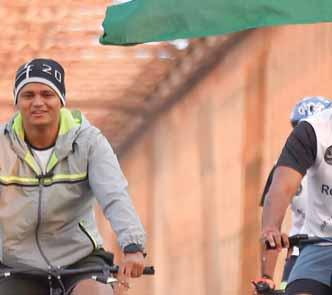
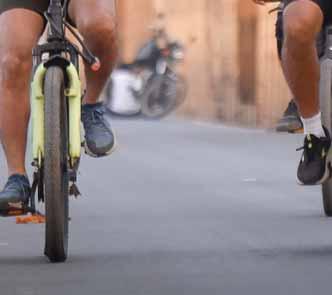

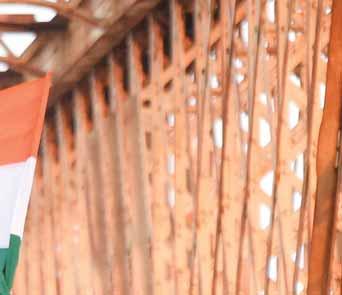
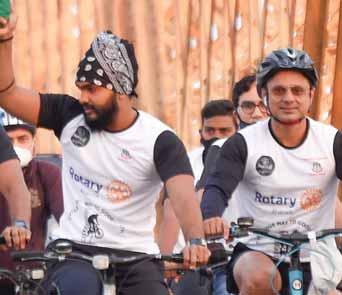

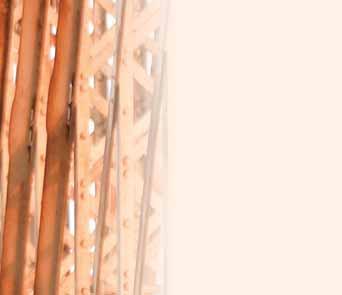
Pedallers and Bharuch Cyclists Association — for the event titled ‘Ride your way to good health’. Expectedly, the event had an enthusiastic participation from both its Rotaract (45 members) and Interact (35 members) clubs, as well as the Rotary Community Corps, Bharuch.


with a message
Rasheeda Bhagat
The cyclists made their way through the iconic and hereditary bridge called the Golden Bridge that connects the two cities of Bharuch and Ankleshwar (Borbhatha) on the banks of the Narmada river. This bridge was built during the British era in 1881, as they needed a bridge across the Narmada river to create trade and administration access for the empire’s officials visiting Gujarat from Bombay. This bridge is also called the Narmada Bridge, but over the years, a new and parallel bridge was built to handle heavy traffic. Rachana adds that at the moment two wheelers are allowed to ride across the old or Golden Bridge so their cycle rally could make its way through this bridge, providing an excellent photo opportunity.
After crossing the bridge, near Borbhatha, the cyclists paused to clean the place to underline the need to protect our environment and cleared the place of polythene bags, plastic bottles and other garbage that people carelessly fling here. “The event was well covered both in the print and electronic media and the cyclothon achieved its objective of increasing awareness on both the environment and health and fitness and also boosted Rotary’s public image,” she added.

More important, several of the cyclists, particularly Rotaractors and other young participants, also resolved to use the cycle as their mode of communication for at least
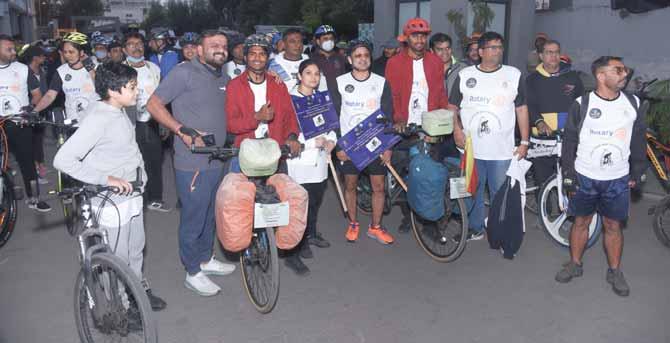
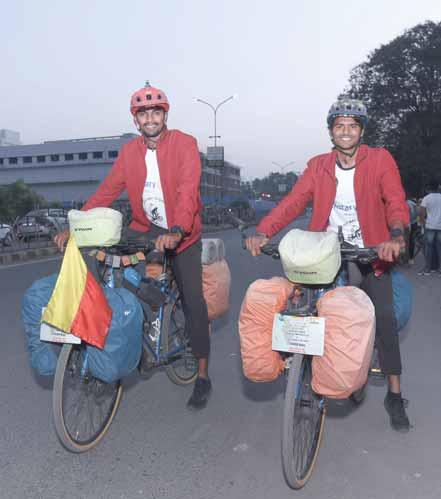
one trip per day in the week, and this is “Rotary’s contribution to reducing pollution in the city, in whatever little way we can,” added Dr Premkumar.
“We are hoping that our small step of trying to switch just one trip per day from driving a car to cycling will reduce the carbon footprint by about 0.5 tonnes per person every year, and when compounded, this can add up to an impressive number,” says Rachana.
The club also hosted at this event the two Rotaractors, Dhanush and Hemant, from the Rotaract Club of Shishu Mandir, sponsored by Rotary Club of Bangalore Whitefield Central, RID 3190, who are on a 25,000 km, single country cyclothon to set a Guinness World Record for the longest journey by cycle in a single country. They were flagged off on this ride from Bangalore on July 11 by RID 3190 DG Fazal Mahmood, and “have already completed 15,000 km of their 25,000 km journey. We hosted them for one evening and then they left for Surat,” Rachana added.
Rasheeda Bhagat
For educated youth to get meaningful employment, they need more than academic education, with selfconfidence and personality development being crucial attributes. But many educated youngsters today lack these attributes. So making use of the opportunity provided by the RILM’s TEACH programme, and zeroing in on the training aspect of the programme, Rotary Club Puttur Central, a relatively new club in RID 3181, set up three years ago, has undertaken an ambitious training programme focused on personality development of pre-university students
in mostly rural colleges at Puttur in Dakshin Karnataka.
Titled ‘Arivu’ (wisdom in Kannada), this project aims to give youngsters adequate training and life skills, along with self-confidence and good communication ability to enable them to get meaningful employment. Club president Navinchandra Naik explained that this is a long-term endeavour and the all-encompassing programme will tackle the repercussions of too much focus on academic studies, grades, hectic competition and rivalry, “all the variables that have accelerated the rat race in
which today’s students find themselves trapped. The necessity of the hour is the general understanding of life skills that will equip our youngsters to gain both knowledge and wisdom.”
At the end of the day, the course will aim to make the youth it trains become responsible citizens. He defines “life skills as a positive attitude with democratic values, respect for the law of the land, and sensitivity to contribute their mite to the welfare of the community which has given them so much.”
Add to this the value of ethics, a keen interest in safeguarding the environment of planet earth and
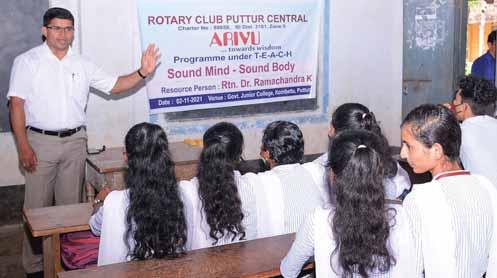
self-confidence to stand up for one’s values and rights, and the students who complete this training course will have the right mindset to go in for higher education and skills for the vocation they choose, he added.
Giving the genesis of the project, its coordinator and charter secretary of the club Sanath Rai says that its roots lie in the students of Karnataka missing out two vital years of education during the corona pandemic. They all passed Class 8 and 9 and were promoted to Class 10, but their foundation was inadequate, as the classes were held only online and the vital teacher-student interaction was missing. “We all know that the education that children get in Class 8 and 9 is vital as they face the board exams the next year. So to help such students the Vidya SetuVidhyabhiyana programme was initiated by the Rotary clubs in Karnataka with the help of Digvijaya News and Vijayavani Kannada daily, sponsors through
advertisements and generous Rotarians across the state.”
In this project a set of two books in Kannada was distributed free of cost to the students of Class 10 studying in Kannada medium government schools. “These books contain simplified versions of the curriculum content of English, Maths and Science taught in Class 8 and 9. These books were approved by experienced teachers,” he adds. The books costing `250 were given to Rotary clubs at a subsidised cost of `100 and it is estimated that around five lakh such books have been distributed throughout Karnataka.
Along with other Rotary clubs in the state, when members of RC Puttur Central started distributing this set of guiding textbooks to schools in their area, “many parents and teachers told us that thanks to the pandemic and disruption in regular classes, their children lacked the required knowledge, discipline to study and also the ability to focus. They appealed to us that if you have or can devise any programme through which you can give some information, knowledge or guidance to these students about the kind of education they
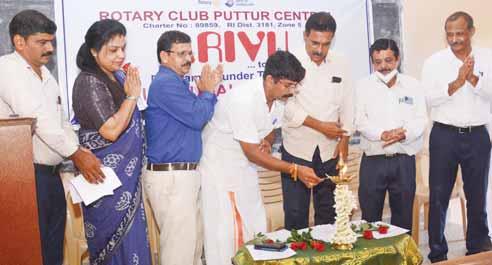
should pursue, it will be good for their future.”
Hence the club conceived the idea of Arivu, and identified distinguished members from their club who were skilled professionals in education, finance, pubic administration, law, and so on. The members include Rtns T Ramesh Babu (tahsildar), Chandrahasa Rai B (former registrar of Karnataka Tulu Sahitya Academy), Rajesh Bejjangala (research professor, Srinivasa University Mangalore), Ramachandra K (director of physical education and placement officer, Government First Grade College), Shivaram MS (associate professor, Vivekananda Engineering College), Chidananda Rai (lawyer), Rakkesh P Shetty (counsellor) and Bharathi S Rai (HoD of English, St Philomena College).
Under Arivu, a one-hour programme is
conducted at government colleges in Puttur, where for 45 minutes training is given in various subjects and a 15-minute interactive session is held with the students.
In all, during the first phase of the project, around 4,700 students from about 17 colleges in Puttur will be covered. Till Decemberend, 28 sessions were held. On this year’s focus being on empowerment of girls, and asked about the participation of girls in this programme, Rai said, “In these 28 sessions, I am happy to say, over 50 per cent of the students were girls, as there are more girls than boys in rural colleges in Karnataka.”
He added that two topics on which the Arivu faculty is concentrating
in the training sessions, which are bilingual, being conducted in both Kannada and English, are problems associated with adolescence and career opportunities available in the Indian defence services.
Depending on the success of this project, the TEACH team is also planning to extend this project to the students of degree colleges as well, said Bharathi S Rai, the club’s chairman of TEACH. The topics covered under Arivu, designed by the club’s trainers, include visualising success and setting goals, career orientation, adolescent problems, competitive exams, social responsibilities and career opportunities in the defence services.
When and as required, other topics can be added and “institutions are free to select the topics of their own interest,” said Naik.
Rasheeda Bhagat
The third wave of Covid has happened with the arrival of the Omicron variant or mutant of the coronavirus. The trying times we live in are well demonstrated by “a Whatsapp message I received. The graph of the food taken in the last two weeks said; bhel puri 10 per cent, sev puri 15 per cent; dosai 20 per cent; curd rice 30 per cent and Dolo 650, 85 per cent,” said infectious diseases specialist Dr V Ramasubramanian, addressing a meeting of the Rotary Club of Madras, RID 3232, of which he is a member.
Giving a brief overview of the corona pandemic, he said that in the last two years, over 300 million people have been infected by this virus and the latest numbers put deaths at over 6 million. “This virus’s ability to keep changing, referred to as frequent mutations, is now known, and Omicron is one such new variant.”
In the healthcare fraternity the major concern was that this variant is able to transmit much more easily than
A positive is that the Omicron mutant causes a very mild disease in most people, unlike the Delta variant, which causes mortality, and serious complications in many people.

the earlier variant “and has the ability to evade our immune response caused either by the vaccine or by a previous infection. This, it was feared, might make it more virulent or nasty, which, fortunately, has not happened. What has happened is its ability to evade certain treatment modalities.”
The Omicron mutant “transmits so phenomenally that we have compared it to the chickenpox virus which notoriously and easily transmits from one person to another,” said the specialist, who is the medical director of the Capstone Multispecialty Clinic.
Giving a simple example, he said, “If you are in the same room with a person who has chickenpox and you’ve not had it and are susceptible to it, there is a 90 per cent chance you will get it by just staying in that room for 15 minutes.” The Omicron variant was “probably not that bad, but is getting there.” But the positive was that it causes a “very mild disease in most people, and unlike the Delta variant, which caused mortality, or serious and multiple complications in a lot of people, death and serious complications from the Omicron are only a fraction of the Delta variant, which is very reassuring.”
Dr Ramasubramanian said that the symptoms are likely to begin with coldlike symptoms… sneezing, a scratchy throat and progression to body pain and fever. But the earlier symptoms of the coronavirus — diarrhoea, loss of taste and smell, are less common. The commonest complaints are cold and sore throat… some complain of severe throat pain which requires more than a paracetamol.
Another difference is that while earlier children were totally spared, “now we are seeing even very young children coming down with fever — 101 or 102 deg C; but fortunately it lasts only for 1–2 days, and they recover. So the good news is that if you feel much better on day 4 or 5, it is most probably Omicron and you just need to isolate for 4–5 days more.”
On treatment, he said the monoclonal antibody cocktail, sometimes referred to as Trumps medicine, has no role to play if one has Omicron. But steroids still work, and are indicated for the elderly who have several comorbidities, develop viral pneumonia and have oxygen saturation below 95 per cent. “Then steroids are indicated and they work.”
After Omicron, wait for at least 2–3 months for a booster shot of vaccine, because the infection itself is like a vaccine. After 3 months the antibodies level falls, so booster can be taken. Don’t take vaccine when you have fever; wait for a day or two. Taking a shot when you have an ordinary cold is fine, as long as you know it is not Covid-related.
Differentiating between variants — such as Delta or Omicron is not possible because the RT-PCR doesn’t tell you so specifically, and genome sequencing is not done commercially. But symptoms and hints such as high fever in children are likely to be caused by the Omicron variant. Fever lasting beyond 5–6 days and loss of taste and smell is likely to be Delta. Bottomline: you cannot differentiate categorically.
Just because Omicron creates mild disease, parties/gatherings akin to the chickenpox parties of yore, when children were put together in a room with an infected child so that all of them could get the infection and get immunity, are strictly not advised. This is because chickenpox caused a very mild infection in children. Whereas in some people with serious comorbidities Omicron can cause serious damage.
Treatment for elderly people who test positive. For those at a high risk of running into complications
“We have seen that vaccine-induced immunity wanes slowly after three months and the levels of antibodies start coming down. We still don’t know what is the protective level of antibodies, so this means we are going by intuitive logic, saying that if these
that might require hospitalisation — people over 60 with multiple comorbidities, people whose immune system is compromised through a renal transplant or patients with immune system diseases — and the doctor knowing that it is the Delta variant, the monoclonal cocktail can be given early. For such patients a 3-day course of Remdesivir is also advisable.
A useful mantra — after testing positive, isolate, take a nutritious diet and stay positive. A positive mindset causes a strong immune system, and helps get rid of the infection.
Risk for the unvaccinated is reasonably high. Vaccines can not only prevent hospitalisation but also minimise transmission because a vaccinated person has a smaller viral load in her throat compared to an unvaccinated person, so the chances of her spreading the infection is much lower. Surface contact transmission is no longer believed to be a threat in spreading the infection as thought in the early days of the pandemic.
We now know it is either spread by droplets, or in a closed unventilated room it can be airborne and spread further than six feet. The chance of surfaces being touched and carrying the disease is almost negligible. But keep washing your hands!
Bizarre cases of a person testing negative a few hours before
boarding a long flight and positive after landing are medically possible, and there is no “cheating” involved as some viral video messages claim. Most likely the traveller had already picked up the virus and it could have been incubating in his body when the first test was taken, and manifested itself only after he landed.
No test is 100 per cent sensitive or specific. Doctors have seen in the same family the spouse being asymptomatic and testing positive, whereas the husband has symptoms but tests negative. The RT-PCR test is 99 per cent specific but it can, at best, pick up only 70 per cent of the infections. The result depends on the way the sample is taken, where the scraping is done, how the process is conducted. So if it’s a positive result, it is positive, but sometimes a false negative is possible.
Travel; countries such as the UK and Singapore have decided that if a person is vaccinated and has good immunity, pre-travel and post-travel checks are not required. I think in the next few months or a year or two, we will have to just move on. Genome sequencing is not yet commercial. A new test from Tata Diagnostics is coming. Termed Omnisure, it will identify only in a few hours whether it is Delta or Omicron. It looks interesting.
levels go down, a booster is needed… call it a booster or third dose of vaccine. The third dose is beneficial if you are over 60 or have a condition that impairs your immune response.”
Clearing doubts on how long one with the Omicron infection should isolate, the expert said different countries
give different deadlines; while the US says five days of isolation after testing positive, and five more days with a compulsory mask if you go out, the UK, Japan and France mandate 10 days’ isolation. The WHO recommends 14 days and the Indian government 7 days of isolation after the test result is positive.
Addressing concerns on what one should do if symptoms such as body pain, sore throat, fever and a running nose appear, he said, “First of all isolate, and don’t panic. If you are young, and vaccinated, isolate for 7 days and then go out. But if you want to confirm what it is and don’t want to wait for seven days, then do the RT-PCR test after two or three days and then remove isolation after another 5 days. If you test positive please don’t panic… I get messages after 9 pm saying I’ve tested positive, what do I do. Relax at home, there is no need to panic, nothing happens immediately or overnight. Stay away from elders; the treatment is purely supportive with paracetamol and anti-histamines for a cold and maybe a cough-suppressing syrup. I don’t think even vitamins are required but we always give vitamins because
In step with RI President Shekhar Mehta’s vision of women’s empowerment, RC Salem, RID 2982, joined hands with Skillsonic HR Group to conduct a mega job fair exclusively for girls at the Rotary Hall in Salem, Tamil Nadu. Over 500 candidates aged 18–21 attended the walk-in interview, said club president J Senthilkumar.
Out of these walk-ins, 130 candidates were selected. “They will be trained and provided suitable jobs at the newly set-up Tata factory in Hosur,” he
it makes the patient feel better. Fortunately, with Omicron, within 4–5 days people do well. But if your cough and fever persist and you are getting worse, do see a doctor again after the 4th or 5th day to check if all is well.”
Answering a question on whether one who has tested Covid-positive should do a test after 11–12 days, or else his name would continue to remain on the positive list, Dr Ramasubramanian said, “No, you don’t need to repeat the test; remember that even after 10 days the rapid antigen test will detect the antigen. It may be dead virus which the RT-PCR test will detect.” The test is so sensitive that “you may test positive even for 10–12 weeks. So please don’t repeat the test.”
For those, he added, who want to return to the US or UK after a 15–20 days vacation, have tested positive and have
to return, several flight authorities accept letters from doctors certifying that the passenger has isolated for the required period, is fit and safe to board a flight.
Doctor’s dilemma
Asked about the biggest challenge doctors like him face during this pandemic, he said it was the overload of information; “there is so much of information out there that most people seem to know more than doctors.” Only the previous week he had a patient’s attender coming to him with a box of medicines, saying, ‘do I give this tablet to him now or will you give after 10 minutes?’ Armed with all kinds of information people come to their own conclusions so it is difficult to practise as a doctor. So unless you are absolutely confident about your decision, this information overload is difficult to handle.
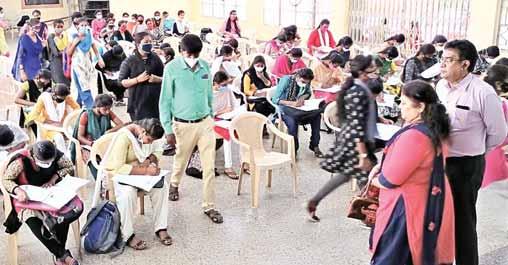
said. The candidates had either completed Class 12 or were diploma holders in electrical, electronics, mechanical, automobile, tool and die-making and mechatronics. They came from various parts of Tamil Nadu and other states. The Tata group’s plant in Hosur will manufacture electronic components and “employ only women right from
the managerial to the workshop cadres,” said Senthilkumar.
Depending on their performance, the selected candidates will get a starting salary ` 18,000– ` 23,000.
DG K Sundharalingam visited the job fair and encouraged the Rotarians to take up more such projects that will empower women.

Trust your spouse when it comes to social service or the way you want to contribute to The Rotary Foundation. These two Rotarians — Nikunj Jhaveri from RC Queen’s Necklace Mumbai and Nitin Mehta from RC Bombay Airport, RID 3141 — had implicit faith in their wives, and were in the limelight as the newly inducted AKS members at the Mahabs 21 institute in Chennai.
Jhaveri is the first AKS member from his club, while Mehta is the first sitting club president (20–21) of the district to have given the commitment last year. Both of
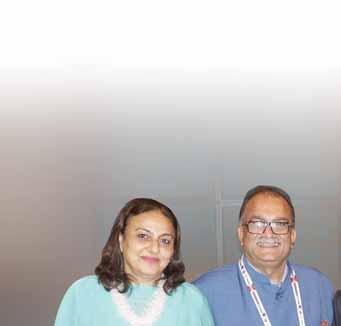
them decided to join the elite club of TRF under the tenure of IPDG Sunnil Mehra who loses no time to encourage members to “give generously to the Foundation.” Listening to their Rotary journey so far is interesting and they both share a common purpose of ‘giving to society what we have gained from it’. For Jhaveri, becoming an AKS member was only a “matter of time as I was contributing regularly to various club, district and global projects.” Having joined Rotary in 2015 to fulfil one of his life goals of ‘doing social service’, he found that he could network with other like-minded people and “leverage their knowledge and expertise with
multiplier effect on generating funds for charity,” he says.
Also, being on the board of many NGOs in Mumbai (Pride India, Lion Tarachand Bapa Hospital, Access Life, etc) helped him realise his vision of giving back to the society. “In Rotary, the concept of global grants struck me, as the amount you donate is channelled to needy people in the entire world. I became an AKS member as the amount ($250,000) will go to the Annual Fund, the key to the success of TRF.”
Jhaveri was inspired by his late father-in-law PDG Jyotindra Vakil, the first AKS member from Asia, to give big to TRF. Moreover, his wife Kanan was the “first one to push me to make the first commitment in November 2020.” At that time the BSE Sensex shot through the roof and “I wanted to give a part of that unexpected gains I made from the stock market to the Foundation.”

He owns Systems Plus Technologies which has offices in



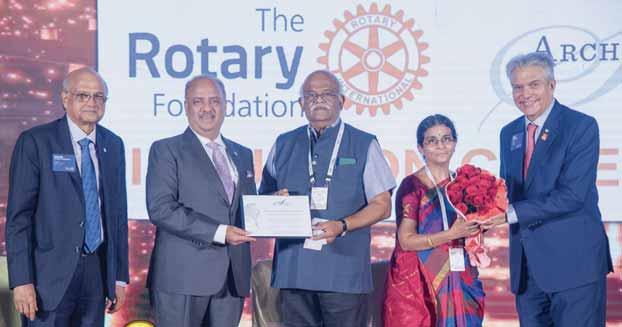
Mumbai, Pune and a couple of offshore centres. With two sons and a large-hearted spouse, “I will continue to give to the Foundation in the coming years too,” he smiles.
Just a single RTGS
Until his 25th year as Rotarian, Nitin Mehta, a stock broker, had given only $1,525 to TRF. But in Feb 2021, a day after Valentine’s Day, his spouse Harsha advised him to make the AKS commitment. In a single RTGS transaction, he paid $250,000 on that day to TRF. “Now as past president, I am mentoring the club to do GG projects and community initiatives,” he says. Two GG projects involving setting up oxygen generation plants at Navi Mumbai and Palwal (Haryana) were initiated by him as club president and now they are in the final stages of completion. Mehta has some enviable records as club president — highest TRF collection of $435,000 (20–21) among clubs in RID 3141,
Many people have the money, all you need is the heart to give it. AKS is for the ones with a big heart.
VR
Muthu
District Governor Elect, RID 3212
second in Asia; and highest GG projects ($433,000) his club has ever done in a year.
Harsha says one of her daughters-in-law, as the Bengaluru head of Cuddles Foundation, an NGO, is doing commendable work for cancer-afflicted children.
Rotary’s DNA of giving and supporting communities has touched millions of lives in the world, says IPDG Sunnil Mehra, who was jubilant after being honoured by RI President Mehta at the TRF dinner.
He recounts that RID 3141 has 36 AKS members, the highest
among Rotary districts in the world; RC Bombay has 11 AKS members, highest among Rotary clubs; and during his tenure as governor, he set a new record for inducting 8 AKS members, beating the earlier 10-year-old record of 7 AKS members in RID 3040.
“Though Covid is a healthcare disaster, we touched the hearts of members who joined the AKS club and others who contributed liberally to TRF. The pandemic, in a way, opened new opportunities for us,” smiles Mehra.
When he donated to the Foundation for the very first time “I wasn’t driving a BMW or owned a sea-facing property. When you give with an open heart you receive more than you expect in return,” says PDG Vinay Kulkarni of RID 3131. After surviving a car accident in 1994 “that almost killed me, I felt as though god has given me this second life
to do good in the world and help those in need,” he says.
He recalls the time when PRIP Kalyan Banerjee was RI president and wanted to do a healthcare project in Africa. “The mother and child healthcare facilities in east and west Africa were substandard. We donated 100 incubators and that got me thinking what more can I do?”
Kulkarni feels that investing in the Rotary Endowment Fund is a smart move “because it is a permanent and sustainable source of funding. Investment earnings are used to provide a permanent source of income to support Foundation programmes and give future generations of Rotarians the additional resources they need to design and implement sustainable projects year after year. Plus, so much more can be done with the return on your investment.”
Having donated $500,000, Vinay and IPDG Rashmi Kulkarni are part of the AKS Trustee Chair Circle; “to us, Rotary is not an assignment or a designation. It is part of our everyday life,” he says. With another donation of $140,000, the couple is all set to carry out 10,000 cataract surgeries in India and has donated three dialysis units worth $30,000 to a hospital in Mahad, Maharashtra, as Directed Gift to TRF.
His focus is to End Polio Lead by example, says VR Muthu, DGE (RID 3212), who has donated $300,000 to the Rotary Foundation. He is inspired by his mother VR Jagathambal, who donated $30,000 last year to the Directed Gifts Fund. He is happy to be the first AKS member from RID 3212.
“My action is the best way to motivate Rotarians in my
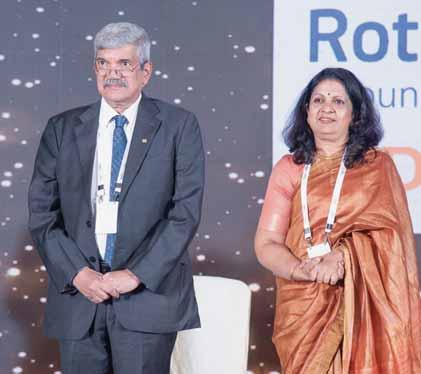
When you give with an open heart you receive more than you expect in return.
Vinay Kulkarni
Past District Governor, RID 3131
district.” He proudly recalls that in June 2020, when he was responsible for collecting TRF funds in his district, “within 10 days we collected `1 crore and donated it to TRF.”
He later convinced his family to donate to the End Polio Fund, a cause that is close to his heart. “We have a responsibility to rid the world of this crippling disease and ensure every child is safe,” he says. He is also keen on giving to the Annual Fund which “lets you choose how often and how much you want to give. It’s a simple and secure way to make a big impact.”
As chairman of a family-run business with an annual turnover of `1,800 crore he finds “giving to the Foundation is easy. But inspiring others to give, is not easy. Many people have the money, all you need is the heart to give it. AKS is for the ones with a big heart.”
His current interest is the RYLA initiative. His club — RC Virudhunagar — hosts a monthly three-day RYLA programme where participants from all over Tamil Nadu are encouraged and trained to become entrepreneurs. Two winners (every month) are sent to Singapore for a fullyfunded four-day entrepreneurship training programme.
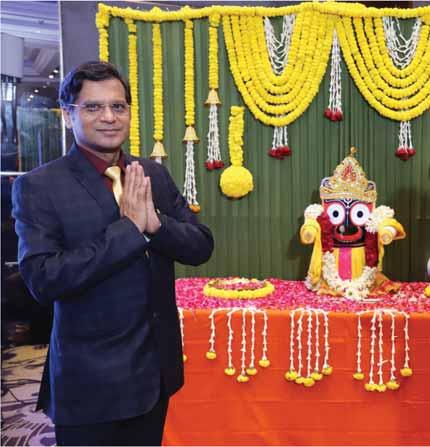
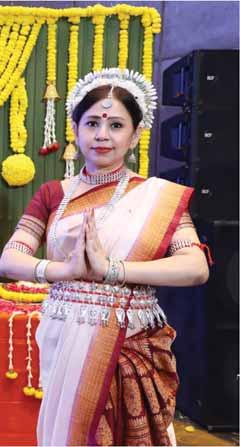
Giving an impressive example of the kind of remarkable service a young, 21-month-old club can render, the Rotary Club of Delhi Ananta, RID 3012, has launched a mega hospital and a training and skilling project costing a whopping `8.5 crore. Right from acquiring land to
building a four-floor facility, in a record time in the Greater Noida area which is home to numerous poor families, the Rotary Ananta Charitable Hospital, which will basically cater to the underprivileged, was inaugurated recently by DG Ashok Aggarwal.
Commending the young club with 50 members for
conceiving and executing such a mega project, he said, “It is really admirable that the club members worked with focus and dedication during a pandemic time such as we are facing now, to put up such a major healthcare and skilling facility for underprovided people in the NCR in such a record time.”
Giving details of the project club president Amitansu Satpathy says that as soon as the club came into being “we wanted to do something much more memorable than routine projects such as blood donation or vaccination camps. We said we will do a permanent project which will last beyond
one or two club presidents’ tenure and would be continued year after year.”
The second resolve of the core group of the club was they would set up a centre of excellence in both healthcare and education/training. First of all the members identified a plot of land, around 1,000 square metres, in an area where there are no affordable diagnostic facilities, and where the people needed skills to improve their livelihood prospects. The land was bought for about `1.7 crore.
The plan was to put up a four-floor building, in which one floor would be reserved for a centre of excellence in training young students in computers, and running skilling courses for women such as nursing, tailoring, embroidery etc, to improve their income generation.
On how the club is going around raising the money for the ambitious


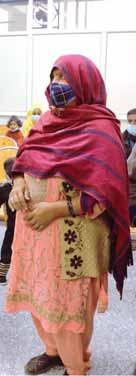
Aruna (centre), wife of DG Ashok Aggarwal, and club members interacting with outpatients at the hospital.
project exceeding `8 crore, Satpathy says, “Of the total cost of `8.5 crore, we have already raised around `4.82 crore from our club members.” Believing in the adage charity begins at home, he himself has donated `22 lakh; “others, depending on their personal capacity, donated `10, 20, 33 or even 50 lakh. Many members have
Through this permanent mega project, our club is committed to serving at least 100,000 people every year; and this is possible as it can cater to over 300 OPs a day.
Amitansu Satpathy president, RC Delhi Ananta
given `11 lakh because we decided that those who give `11 lakh or more will be made permanent trustees. The remaining money we are trying to raise through CSR funds of companies.”
On why they had not taken the global grant route, he says that option also has been explored and “recently a GG was sanctioned for an eye hospital which is going to cost around `1 crore”. But he expressed the club members’ frustration with getting a global grant sanctioned saying: “We found the GG process very tedious, there are so many questions asked, we struggled for two years to get the money sanctioned (for the eye hospital). That
is the reason we decided to put our own money and raised `4.82 crore.”
On New Year’s day, DG Aggarwal also inaugurated in the hospital an x-ray facility costing `20 lakh, which was donated by club member Surinder Arora, through his Virgo Group, manufacturers of plywood and laminates.
Charter president of the club Rakesh Jain explains that the second floor is reserved exclusively for computer education of young people from poor families, who are missing out on education imparted through online classes as they have no digital knowledge of any kind. So youngsters will be trained to use both computers and tablets.
Apart from this computer facility, computer centres, each costing about `8 lakh will be set up in 12–15 schools in the NCR, “particularly UP villages, and the club hopes to spend an additional `1 crore on this project,” adds Satpathy.
Past president of the club Manoj Agarwal explains that more than treatment for diseases, this charitable hospital is for outpatients (OPs), giving free medicines and will provide diagnostic facilities like CT scan and other expensive tests that the poor cannot otherwise afford. Here these tests will be done at a very low price, such as only `100 being charged for a CT scan, or `50 for an x-ray. Soon a dialysis facility will also be introduced.
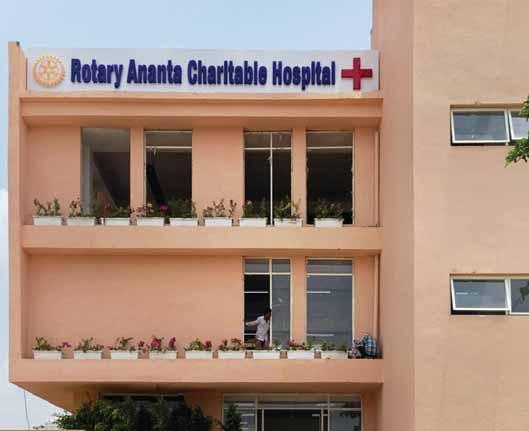
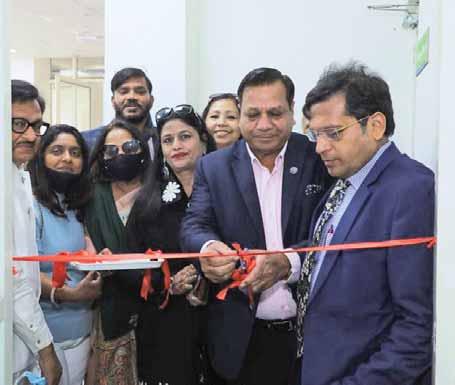
“We also want to bring in high-end diagnostic facilities including MRI. On the inaugural day itself some 100 OPs came in, and free medicines were given to some 50 of them,” he says.
Satpathy adds, “Through this permanent mega project, our club is committed to serving at least 100,000 people every year; and this is possible as it can cater to over 300 outpatients a day.”
It was a proud day for him when RI President Shekhar Mehta, on a visit to Ghaziabad, while honouring him as a major donor, “singled out our hospital project and appreciated its permanent nature, saying that these are the kind of projects he wishes to see through the Rotary world.”



4-8 JUNE 2022





Rotary at a glance Rotary








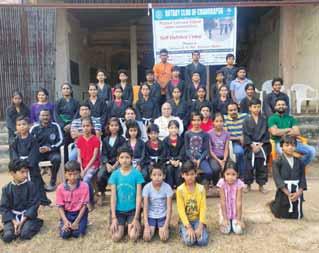
Rotary Club of Chandrapur imparted self-defence lessons to 30 girls at the Jubilee High School. The program is in District 3030’s agenda DG Ramesh Meher is of the view that girls should be able to protect themselves, take care of themselves and do excellent work in the society to create a better and healthier society and to fulfil their dream, our club should also have a share, said club president Shrikant Reshimwale. The training was provided by the Martial Arts and School Games Association. All the girls were adorned with ‘Yellow Belt’ and a certificate by DG Meher on November 12, 2021. Project Director of the event was Uttam Dakre and Suraj Wagh. Club Secretary Avinash Uttarwar delivered the vote of thanks.
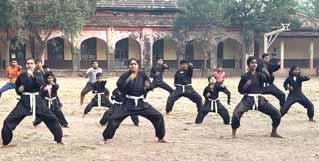
For Rotary Nagpur Ishanya, muskaan has a deeper meaning than just a smile. The club’s flagship project — Muskaan — is an attempt to uplift and inspire the under privilegedchildren of the society. This was the 10th edition of ‘Muskaan’.
And, it was different this time. For the first time the club hosted 227 children for two days. For the 227 children from the Baba Amte’s Hemalkasa Anand Ashram, it was a unique, novel experience in many aspects. It was their first ever outing outside the Ashram, first ever bus journey, first ride on the Metro and their interaction with the outside world.
The participation this year was bigger with
107 children from Katol road Vidhyalaya
10 children from Bal Sadan Anath Ashram
227 tribal children from Baba Amte’s Hemalkasa
59 children from Nutan Bharat
150 children from Pandit Nehru Hajaripahad
The children had a fun-filled day at Divya Nirmal Dham Ashram (Sudhanshu Maharaj Ashram), Suraburdi where they played many games organised by the entire team of Muskaan. The dance session was full on Masti for them and our members too. The kids were amused by the aero-modelling show.
It was heartening to note how they asked for serving food in small quantities; in the process, spreading a message to avoid food wastage. All the children were excited to receive their goodie bags when they were dropped off at their respective homes. .
All Covid protocols such as wearing masks and frequent use of hand sanitiser were followed by the students, caretakers, accompanying staff and the club members. Club members, led by president Pritesh Chandak, worked tirelessly towards the success of the project.
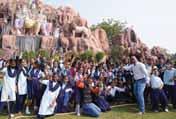







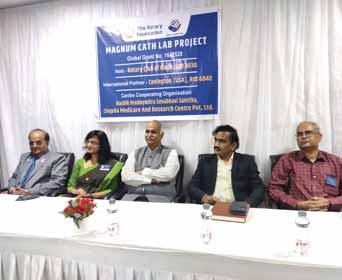
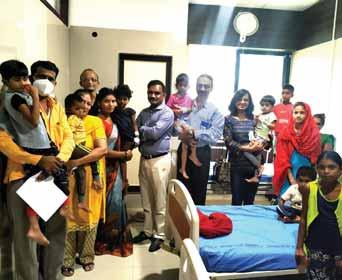
Congenital anomalies in heart occurs at birth. It can lead to stunted growth, poor health of the child and can lead to premature death. However if diagnosed and treated in time, this is fully curable and children can then lead a healthy life.
These anomalies in medical terms are called PDA, VSD, ASD, RSOV and MAPCA.In layman’s terms, they mean some problems in the chambers of the heart. The effect is lack of supply of oxygenated blood to different parts of body which manifests as stunted growth. Even though curable through surgery, the medical equipment needed for treatment are expensive, and so the cost of surgeries become unaffordable for the underprivileged. costs in corers. End result
RC Nasik decided to establish such facilities in Nashik through GG to enable cost-free treatment to children of marginalised families. TRF was most helpful and approved the Magnum Cath Lab Project under GG1642528. “.
Despite the Covid pandemic, work continued diligently and orders were placed with a Japanese manufacturer. The equipment arrived in Mumbai and was finally installed at the Magnum Heart Institute in Nashik. DG Meher inaugurated the facility on 27 August ’21.
Now the task was to identify children with congenital heart disorder. From the initial health check up to ECG and more tests, children have to undergo various screening. Then starts the counselling process of their parents. Experts explain them the issues at hand, possible treatment and prospects of healthy life for their children. All this process was going on simultaneously in the many adivasi padas around Nashik while the equipment was getting installed. A batch of 14 children aged between 2 to 17 years was selected for this bloodless surgical procedure with the help of the newly commissioned machine.
A team led by renowned cardiac surgeon of Nashik, Dr Manoj Chopda, carried out the pinhole surgeries on these 14 selected children on Oct 5 and 6. Within a week, all the children were discharged and post operative visit confirmed that these children are now leading a very healthy and happy life!
Twenty-five such free surgeries will be carried out every year, bringing not only smiles on the faces of parents but helping these children become healthy and happy citizens of India.

ne of the sessions at the zone institute Mahabs 21 chaired by RI Director Mahesh Kotbagi sought to clear doubts and shed some light on the nitty-gritty of TRF grants.
To the one question which always pops up at such TRF sessions on GGs, which pertains to so many questions being asked by RI staff before sanctioning a GG, incoming TRF Trustee Bharat Pandya said: “If you go to a bank and apply for a loan, they will ask you 50 questions; ask for a guarantor, documents, mortgage on your house, and so on. Here the Foundation is giving you money without asking for anything except a few questions, which are relevant. And TRF doesn’t charge any interest.”
Furthermore, he added, “and it is not even a loan; they are giving away that money just because of your title ‘Rotarian’. So to uphold that name of Rotarians, even if they ask questions five or 10 times, we should not be complaining.”
Directing a question to RI President Shekhar Mehta, Kotbagi asked: “There are so many questions on grants and confusion about giving to different kinds of the grants in the Foundation. Your own club — RC Calcutta Mahanagar — does 10 GGs at a given time, which I think is the cap on the number a club can do simultaneously. So how is it possible for a single club to have so many grants, and how do your members do it?”
Responding, Mehta said that he was often amazed to find, in some districts that he has visited, that the “entire district has done only some
Rasheeda Bhagat
four grants in the previous five years. So I tell them that when my club, a single one, can do 10 grants, why can’t an entire district do a sizable number?”
Mehta said that in any club eager to do community service projects, the biggest challenge the president and his office-bearers face is funds. “And the easiest way to get funds is from a TRF grant.” In a lighter vein, he said the two things that invariably failed were a PowerPoint presentation which did not come on, and fundraising efforts. “Ninety per cent of the time in clubs your grandiose fundraising plans won’t work. But with a TRF grant you can achieve amazing success in executing a project.”
He suggested that for those districts which do less than 15 global grants, maybe the TRF trustee in the region can organise a workshop on how to go about getting a GG. He disclosed that he was lucky that before he
became the district governor, the culture of going in for a global grant was started in his district “by his predecessor and I reaped the benefits. We did 100 GGs in one year. And all because we were ready to put in a bit of effort.”
Mehta told the RI officers in the hall that all of them worked with finance in one capacity or the other and “should know and understand how the grant papers work. Yes, thereafter there are several issues, pertaining to stewardship, etc, but doing GGs is extremely easy. Through these grants you are not only doing service to your communities but also giving an opportunity to the Rotary clubs in the US, Australia and European countries, who do not have an opportunity to do community service as we do in this part of the world, to participate in service activities.”
Pandya added that just as Mehta’s club was an expert in doing many
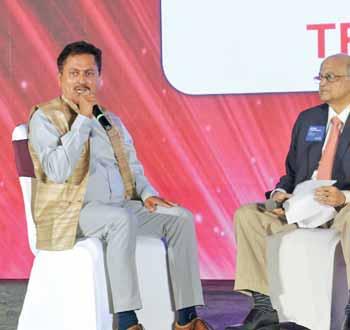

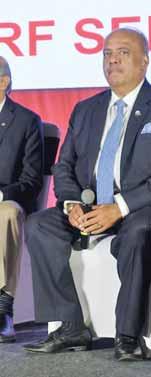
GGs, “several times while visiting a district I am surprised to hear that the entire district did one RYLA. Let me share that in Rotary’s centennial year in RID 3140, the target of the governor was to do 100 RYLAs and we did 101. So as Shekhar said the question is of mindset and training.”
The next question by Kotbagi was addressed to Pandya on Rotary cadres and how much help and expertise they could give the districts in doing a GG. “While PRID Manoj Desai, who headed the Rotary cadres last year can shed more light, I’d say the cadre plays a very important role in monitoring the global grants. Not just monitoring but also the training aspect. We have about 129 cadres in our zones, who are experts not only in monitoring but also guiding people on grants. My request to the district leadership team here — present, past and future — is to make optimum use of this excellent resource of the cadres.”
He requested RISAO’s Sanjay Parmar to share the details of the

cadres with the current and incoming district leaders. The wisdom of the cadre could be used even in the pre-planning of grants.
TRF Trustee Gulam Vahanvaty, who was on the panel, added: “We have already transmitted the information of the cadre members of each district and requested the DGs to print their contact details in their district directory. Sanjay and I had worked on this last year and it needs to be followed up.”
He requested Pandya and the DGEs to ensure this as the cadres could be very useful resources who could be involved even in the preplanning of grants. President Mehta added this information be made available on rotaryindia.org, with their district names, though their services were not restricted to particular Rotary districts. “Somebody who is an expert in water can train anybody anywhere.”
Kotbagi next quizzed Vahanvaty on complaints from “districts and the smaller clubs saying they face a lot of difficulty in getting grants and international partners. Many smaller clubs feel the trustee from our zones should play a role and make effort to club smaller clubs together and enable them to do a GG, irrespective of their contribution to TRF.”
Vahanvaty responded that there is “a concerted effort to ensure that districts which have very little DDFs are supported by districts with a higher DDF. Particularly, as a global grant is something that addresses community
From L: RI Director Mahesh Kotbagi, TRF Trustee Gulam Vahanvaty, RI President Shekhar Mehta and Trustee-elect Bharat Pandya.
I’ve promised to many African countries that we are ready to give, they have to tell us what they need.
Shekhar Mehta RI President
needs, people go out of the way to support the smaller districts.”
The bigger problem we face is the difficult situation where you have no track record. “Take for example President Shekhar’s club — RC Calcutta Mahanagar; it will never face difficulty because if you have 10 open grants every year that means you have never faced a stewardship issue all these years. More and more international clubs will say we want to partner with you. But the clubs which have no track record are the ones that need assistance and I have already helped some clubs and districts get international partnerships. All of us have friends across the world and we can help out.”
He assured the institute participants that they can tell their clubs that “if you have a project that addresses or meets your local community needs, you will not be found wanting for funds.”
President Mehta added that all clubs such as his home club, “should reach out to the smaller clubs and the DG should act as a facilitator where the smaller clubs join the bigger one with an international partner and do the GG. This will be their opportunity to get into a GG, taste what is like and learn how to create relationships with foreign partners. In the next step they can go ahead and do GGs on their own.”
Another question pertained to the lament from districts that when they apply for a grant, so many questions are asked by the RI staff, specially at Evanston, saying this is not the right evaluation or the right cost. The complaint was “how does one sit in Evanston and understand the importance of the local issues in Bikaner, Calcutta, Jharkhand or rural Maharashtra?”
Taking on this query, Mehta said this was akin to the Bengali adage which translates to “ma ko mausi ki kahaniya sunana (telling your mother her sister’s stories). I keep raking up this issue all the time with the Rotary staff (in Evanston) that we need to regionalise on these issues. How can somebody sitting at the RI headquarters understand the literacy programmes and needs in Argentina, Africa, India or Bangladesh? This should get regionalised and Sanjay Parmar and his colleagues should get more empowered. If necessary, they can be trained; after all there are experts in literacy, particularly one person at the RI headquarters who is an expert and understands literacy issues in different regions. But let’s have such persons even in regional office; efforts are already being made and I am confident this will happen soon.”
Mehta advised the Rotary leaders in the hall that they should not worry about the questions that are raised pertaining to GGs. He revealed that after “many years and taking some interest, three years ago I became a contact person for GGs and learnt a whole lot of new things… the planning which needs to be done and so on, and shared this information with my club. You may think their questions are irrelevant but that is because you don’t understand the impact of that question.”
Vahanvaty said the process of regionalisation had already begun
If you go to a bank for a loan, they will ask you 50 questions; ask for a guarantor, documents, mortgage on your house. Here the Foundation is giving you money without interest and asking you only a few relevant questions.
Bharat Pandya TRF Trustee Elect
with CSR funds. “Today thanks to the work done by the RISAO staff, CSR grants, which are exclusive to India, are vetted and sanctioned at the South Asia office.” Parmar and two of his colleagues now handle CSR grants “very effectively. Let’s be very clear that the questions they ask are extremely important.”
Vahanvaty added that as he was involved in stewardship issues, “I completely agree with Shekhar and Bharat that the money that is given to you… sometimes to the tune of $100,000, just on your signature, is because you are a Rotarian and they trust you. Therefore, the questions are important, not only prior to the grant sanction; we have to ensure that the grant is used for the project in the highest traditions of Rotary stewardship.
To Kotbagi’s next question on whistleblowing being done for “political reasons, with the result that the person who is not guilty suffers,” Pandya said, “First of all, we have to ensure zero tolerance for improper use of grant funds… funds used for another purpose than the one for which they were given.” While
there was a big improvement in this issue, “let us decide that even five per cent wrongdoing will not be tolerated.”
On whistleblowing and some individuals in clubs suffering, a general statement can’t be made, he said. “But if the leadership of the district or zone is suffering because the whistle was wrongly blown then we must definitely walk the extra mile to see that injustice doesn’t happen to that person.”
Adding to this, Vahanvaty said, “When a whistleblower sends a complaint, it is not automatically accepted. It first goes to the stewardship staff, they do a paper audit to see if there is any truth in it. If they feel there is some truth in it, then they appoint a cadre to look into it. So, if somebody is victimised it can happen only if there is justification in it, otherwise people will lose faith in us.”
Answering a question on increasing the per capita giving to TRF by Indian clubs, Pandya said, “First of all, we must dissociate the grants we get from what people are giving. Let’s not keep telling people that because we are getting so much, we should be giving more. As Shekhar is the RI president this year, this is the year for us to start giving, not because we are getting so much but because it is our responsibility and duty to give.”
“Also, giving to the Annual Fund is very important, because if that dries up then I don’t think the work that is happening in our part of the world can continue.”
Vahanvaty added, “There has been a change last year; we did $800,000 in that fund. I think we are realising its importance but we have to keep stressing that giving to the Annual Fund is very important.”
Mehta reiterated that during this year, Indian clubs will do 10 per cent of GGs outside India. “I’ve promised to many African countries that we are ready to give, they have to tell us what they need.”

RC Chandigarh Central, RID 3080, under its project
“Ek Haath Aasha Ka” fitted LN-4 prosthetic arms for 1,340 beneficiaries at a four-day camp held at the Chandigarh University.
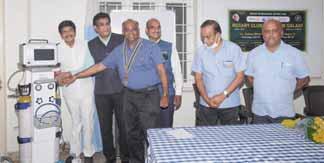
PDG EK Sagadhevan, DG K Sundharalingam, club president PL Yegappan, AG Dr Rajesh, project chairman
Vasanth Pusalkar and club secretary A Udayappan at the inauguration of the medical equipment.
RC Salem Galaxy, RID 2982, provided a medical equipment worth `11.5 lakh to the Salem Polyclinic. The machine helps provide thermal stability to premature babies kept in ventilators.
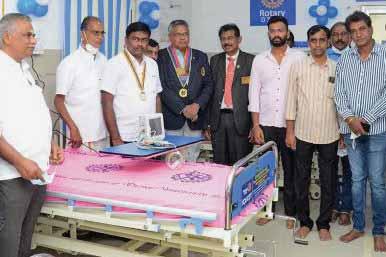
RC Tirupur West, RID 3203, set up a Covid ICU at the Palladam Government Hospital, Tirupur. The global grant project worth `32.71 lakh was inaugurated by DG K Shanmugasundaram in the presence of DGN Dr S Sundararajan, PDG A Karthikeyan and club president L Nagaraj.
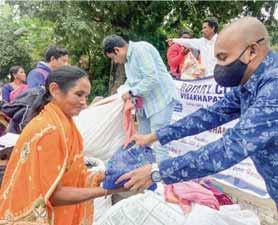

Club members of RC Visakhapatnam, RID 3020, with the help of general public, collected clothes, winter wear and bedsheets over a month and distributed them to 500 people in Paderu, a tribal area near the city.
V Muthukumaran
Rotary is doing the work of god and Rotarians have the power to touch and change lives which is a big gift. “So let us come together to turn the wheel and serve to change lives,” said RI President Shekhar Mehta at an event in Amravati to felicitate TRF donors and clubs which have surpassed membership targets in RID 3030.
Amazed by the healthcare projects, most of them permanent ones, and community initiatives being done by all the four clubs in Amravati, he urged the club presidents and secretaries to make “the best use of the rest of the Rotary year as this is once-in-alifetime opportunity.” DG Ramesh Meher was doing a great job and he will be followed by DGE Anand Jhunjhunwala and DGN Asha Venugopal, so there is plenty of ‘happiness’ and ‘hope’ to follow.
“A small city with just 5–7 lakh population, Amravati has some of the most outstanding projects under the leadership of PDG Kishor Kedia and Meher,” he said. Recalling his early days in Rotary and the way it transformed him, Mehta called for
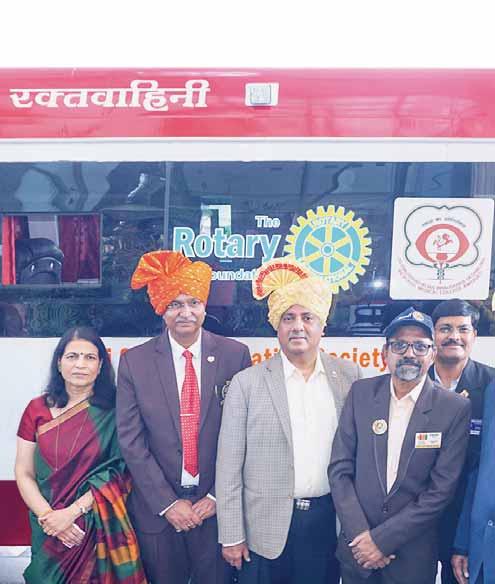
RI President Shekhar Mehta at the inauguration of blood donation van in the presence of (from L) Sharda, DG Ramesh Meher, RC Amravati Midtown past president Vinayak Kadu, president Anand Dashpute, PDG Kishor Kedia and PDG Mahesh Mokalkar.
introspection over two contrasting worlds, one with haves and the other with have-nots. “We have to understand the pain of the deprived and try to mitigate it.” The beauty of Rotary is that it gives one a platform to make the world a better place to live in by making the “lame walk, blind see and healing the sick.”
Club presidents have their task cut out for the rest of the year.
“I have held many top positions in Rotary, but I enjoyed most the one as president of my club as you have so much work to do,” he said. His twin mantras — Grow more, do more; and Each one, bring one — will enable Rotary to increase its membership to 1.3 million, with our zones contributing substantially.
In his address, DG Meher assured Mehta that his district will cross the target of inducting 1,000 new members by June 30, 2022. “We want all the 96 clubs (in RID 3030) to get the gold pin by adding over 30 new members each, with nine being women.” The district will train 100,000 girls in self-defence
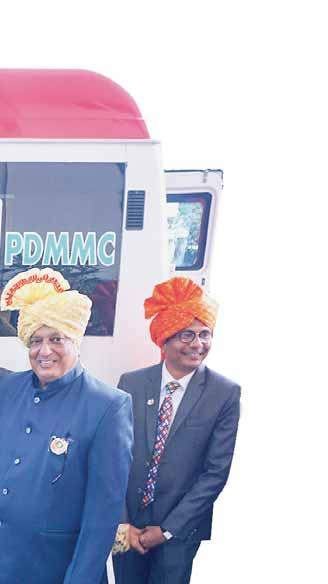
techniques under the Veerangana project, he said.
TRF donors
Five gold pins were put on PDG Rajiv Sharma and Rashmi, the newly-inducted first AKS couple from RID 3030; DGN Asha
Youth power is at the forefront in this Vidarbha region of Maharashtra as Rotary’s District Action Group on Mental Health Initiatives (DAGMHI) with 500 members and 11 board of directors is holding webinars and online counselling to students, Rotaractors, adults and non-Rotarians suffering from depression and anxiety disorders. “We work on a panIndia basis with lot of online sessions and workshops. Though this group was started in 2015, we became active only from July 2021 with the efforts of Dr Aabha Pimprikar from RC
Nasik Grapecity, our president and Dr Rita Aggarwal, advisor, from RC Nagpur,” says Pankaj Agrawal, executive director, DAGMHI.
One of their priorities is taking care of child health through proper counselling and timely intervention. “We have done over 50 webinars, online programmes that offer consultations for general wellbeing of stressed out families and students preparing for exams,” he explains. DAGMHI invites a psychologist or an expert counsellor to guide its online participants. So far, this RAG has touched 2,000 beneficiaries across India. “In the coming years, we will expand our visibility across India through both online and offline programmes,” says Agrawal, a Rotarian for 15 years and IPP of RC Achalpur.
I have held many top positions in Rotary, but I enjoyed most the one as president of my club as you have so much work to do.
Shekhar Mehta RI President
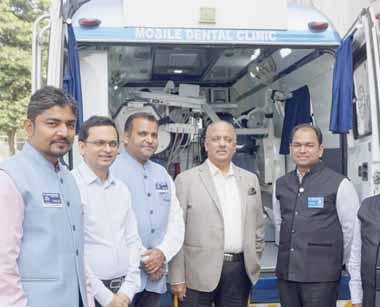


Venugopal for her Endowment Fund contribution ($25,000); PDG Kishabhau Godbole (Endowment); AG Rajendra Pawar and Hemalatha (Major Donors); and past president Udayraj Patwardhan and Rekha (Term Gift: $30,000).
Paul Harris Society chair Anirudh Paldiwal was felicitated for increasing the PHS membership from 19 to 39; Rtn Ravi Mahadeokar from RC Nasik was honoured for initiating two CSR projects — one with Singer company for training rural women in tailoring; and the other with Nestle for a pan-India rollout of a human milk bank. RC Gandhicity Wardha, a 100 per cent PHF club, and RC Nasik City, an EREY club, were honoured. DRFC and PDG Mahesh Mokalkar said the district will meet its target of $500,000 in TRF giving, half of which will be for the Annual Fund.
Membership drive
Three clubs — RCs Nasik, Nagpur Ishanya and Nagpur South — received gold pins for adding over
30 new members; four new clubs were formed and six more are in the pipeline. The district has added 500 new members. DMC Rajesh Vyawahare said, “we are focusing on 100 per cent retention too; our membership has grown from 4,720 to 5,215.” To mark the RI president’s birthday, 175 blood donation camps were held for 15 days across the district, with clubs collecting well over 3,030 units of blood, said DG Meher.

RI President Shekhar Mehta and PDG Kishor Kedia (R) along with (from L) Rtns Anandilal Daga, Pali Arora, RB Atal and Raju Mundhada, project-charge, at the crematorium set up by RC Amravati Midtown.
A blood donation van (GG: `32 lakh), a project of RC Amravati Midtown, was inaugurated by Mehta. This will collect blood from the
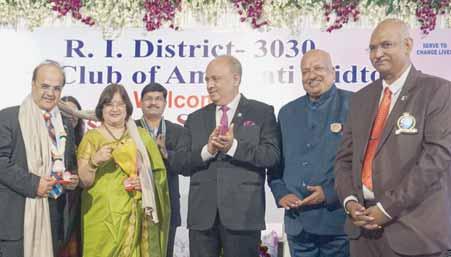
doorsteps of donors in and around the city. Mehta also visited the Dr Panjabrao Deshmukh Memorial Medical College Hospital, in partnership with which the clubs in Amravati do healthcare projects. Set up in March 2016, the human milk bank (GG: `12 lakh) and incubator ward (GG: `10 lakh) take care of the newborns. “While the milk bank has reached out to 7,500 infants, the NICU ward has served over 5,000 babies,” said Dr Rajesh Boob, project in-charge from RC Amravati Midtown. The extra milk donated by lactating mothers will be preserved for six months in cold storage to help mothers who can’t nurse their babies. Though set up in November, the 20-bed palliative care centre (`30 lakh: member donations) will start functioning from December-end, he said. “It will house those with terminal illness, cancer patients, etc,” said
past president Raju Mundhada from Midtown club. Around 2,000 women are being screened every month for cervical and breast cancer by the mammography bus (`1 crore: club funding), with a detection rate of one per cent, since Jan 2018. A high-tech eye check-up (`15 lakh) and dental clinic (`30 lakh) vans are being run by RC Amravati Ambanagari which immensely benefit villagers.
For each dialysis being done at the Rotary Dialysis Centre — `30 lakh for three machines through club funding since March 2020 — at the Kidney Care Centre, “our club pays `700, and the patient, only `400,” said Mundhada. A well-stocked orthopaedic library (`10 lakh) at the Rotary Hall is lending medical beds, oxy concentrators, wheelchairs, etc to needy patients for well over 15 years,” he said.
crematorium
In partnership with the Hindu Smashan Sansthan, a gas crematorium was set up in 2014 for `1.5 crore. “During peak Covid, bodies lined up on either side for cremation and even though we ran this unit 24x7, the waiting period was 7–8 hours. It was a nightmare,” recalled AG Dr PR Somvanshi. An RO unit (`8 lakh) at the Baderna railway station offers drinking water to passengers.
To provide healthcare at remote villages, “we will be conducting four mega camps in the coming months for 1,000 people living in tribal hamlets and rural pockets. General health and hygiene will be the priority at these camps,” said Anand Dashpute, president,
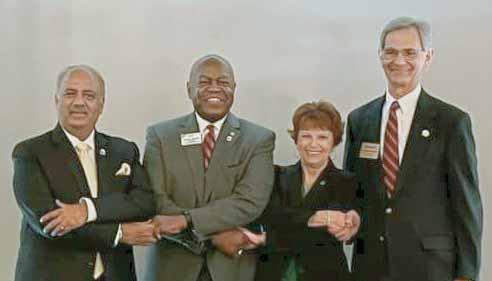
RC Amravati Midtown. He is collaborating with the ISKCON, district collector’s office, and the RSS, to deliver nutritious food and ration kits to 2,000 pregnant women across 300 villages in the Melghat area of Dharani taluk, Amravati district.
Around 100 students in the taluk will be given sweaters and stationery items including notebooks by Midtown club, the biggest in Amravati with 118 members. “There are 16 clubs in Nagpur with 1,700 Rotarians; the 300 Amravati Rotarians with limited resources are doing an excellent job reaching out to the communities,” said Kishore Rathi, chair, Nagpur Enclave, RID 3030.
by V Muthukumaran
Leaders of the four service organisations — Rotary International, Lions, Optimists and the Kiwanis — came together at Pasadena, California, at a meeting organised by a local Rotary club and the Rose Day Parade Committee. Earlier RI President Shekhar Mehta and Rashi led the Rotary Float at the 133rd Rose Parade held in the city on Jan 1. The annual parade, organised by the non-profit Pasadena Tournament of Roses Association, is generally held on new year’s day and is watched by thousands of spectators.

We will do 3 crore mangrove plantations in India,” said
RI President Shekhar Mehta at the Mahabs 21 zone institute in response to a suggestion from Meenakshi Venkataraman, chair, ESRAG (Environmental Sustainability Rotary Action Group) – South Asia chapter. “An alarming 50 per cent of the world’s mangrove forests have disappeared in the last 50 years,” she said, adding that mangroves are particularly efficient at absorbing carbon dioxide from the atmosphere. They are home to vital species in the blue carbon ecosystem and help prevent coastal erosion.
Meenakshi and Mridula Ramesh, founder, Sundaram Climate Institute, presented a plenary session on environment sustainability which was anchored by RI Director Mahesh Kotbagi. He remembered PRID Sushil Gupta for his passion for water projects, elevating the water table, constructing check dams, desilting wells and canals in arid Rajasthan. Meenakshi recalled President Mehta’s speech at the COP26 climate change conference held in Glasgow last November. “He had rightly announced that mangrove restoration will be one of the key threads of Rotary’s environmental focus. The impact of climate
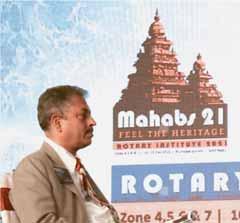
change is rising sea levels, tornadoes and cyclones, and the best and first defenders of these in tropical coastal communities are the mangroves, he had said.”
She pointed out that in India mangroves form only three per cent of the forests. They are more significant in the Sundarbans (West Bengal), Bhitarkanika (Odisha) and the Gulf of Kutch (Gujarat). “We must restore our mangroves on a war-footing, and plant at least one crore mangrove species in each region. We have been doing Miyawaki forests. But it takes 40 years to see any carbon sequestration from these forests. Restoring mangroves will yield result in three years.”

RID Mahesh Kotbagi, ESRAG (South Asia) chair
Meenakshi Venkataraman and Mridula Ramesh, founder, Sundaram Climate Institute.


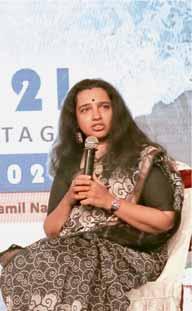

It takes six years of careful nurturing the mangrove plants after which they can be replanted in an estuary. “So we must be prepared for that many years of commitment. But the first-year survival rate is less than 40 per cent,” she warned. Replying to a question on building continuity of projects in clubs, she said, “Just as you have a three-year term for TRF chair in the districts, every district must have an Environment chair for a three-year term.”
With Delhi having the highest number of Electric Vehicles running on rechargeable batteries, Meenakshi recommended that Rotary clubs set up solar charging stations at strategic spots, which “will also add to your public image.” Urging Rotarians to practise what they preach, she said, “If you are happy to provide solar energy in your neighbouring village, go for it. But put one at your home first.”
She drew attention to the wild growth of lantana bushes in the forests.
For the past 18 years, RC Shankerpura, RID 3182, has been regularly organising psychiatric medical camps every month at Shankarapura, a tiny hamlet in Udupi, Karnataka. “When we started the camp in 2004, we treated 20 patients. Today we get about 600 patients every month, some of them coming from the surrounding regions too,” says Edward
For people living in cities these are great-looking plants to grow in our yards, but these are the scourge of our forests. This invasion has affected the growth of native forage plants for wild herbivores, she said.
We cannot reverse the devastating impact of climate change but at least adapt ourselves to halt it to some degree. This can be achieved by understanding the critical link between climate change and waste, said Mridula, adding that every individual must do their bit instead of waiting for the government to provide a solution to their community’s woes.
She related how her home survived one of the worst water crises. “In 2017 Madurai saw the worst drought in 140 years and we were the only house not to buy water. But earlier when our bore well went dry in 2013 we had to spend an insane amount of money purchasing
water from private tankers. I then realised it was time for individual action. That’s when you start discovering, acting and become independent and resilient.”
An advocate of zero-waste concept, she related how she reduced waste generation at her home and factory. “We just need to pretend that we do not have a garbage service and then see how our choices and lifestyle change!”
Much of the kitchen and garden waste that is sent to landfills can be turned into an energy source or fertiliser. “Advocate waste segregation in your community. Managing our wet waste gives us one cylinder of biogas a month,” she added.
Her mantra for doing environmental projects: Act on data and design easy concepts for the project to be sustainable. “Convert your project to bring value to the community and people will nurture it,” she said.
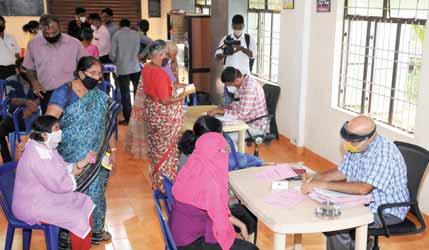
Mendonca, club chairman, psychiatry camps. Medicines worth `30,000 are distributed every month and psychiatrists Dr P V Bhandary from Udupi and Dr Srinivasa Bhat from Mangaluru, along with a team of a counsellor, three pharmacists and a nurse, take care of patients at the camps.
“It is an ongoing project with no fund crunch. Our well-wishers and some Rotarians have deposited considerable amount in fixed deposits in their account and the interest is diverted directly to our Rotary Trust account. We use these funds to run the camps,” says Mendonca.
Graceful dance performances, musical recitals and power-packed sessions with spiritual gurus and celebrities made the Mahabs 21 institute a memorable occasion. Students from the Atma Foundation of Kalakshetra, Chennai, entertained Rotarians with thematic dances. Their group performance in traditional attire and classical dance portrayed the richness of ageless concepts such as truth, ahimsa and education.
Renowned musician and veena player Rajhesh Vaidya and his band kept the audience engaged, as his magical fingers created melodious tunes ranging from retro, Bollywood and peppy Tamil numbers. Whether it was AR Rahman’s lilting melodies from the blockbuster film Roja, or evergreen Bollywood songs such as Piya tu ab to aaja, Mere sapno ki rani, or a jugalbandi between the ghatam and tabla players, the music got the delegates tapping their feet and clapping.
Addressing a session, Aasaanji, a spiritual teacher and founder of the

Atmayoga Foundation, said “you have the ability to change the unchangeable and this is the power that god has blessed you with.” In order to sharpen the intellect, he prescribed regular meditation.
Lifestyle coach and motivational speaker Gaur Gopal Das praised Rotarians for their selfless service through charity. The paradox of our times is that those “who have the
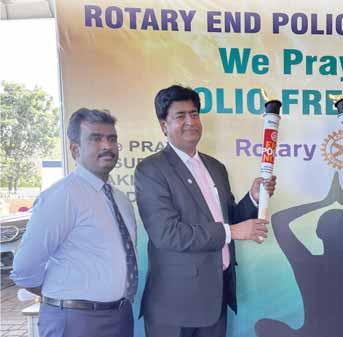
most are often the least satisfied.” He advised Rotarians not to forget that “good values, family and friends are the key to success.” Leadership coach Prakash Iyer peppered his presentation with anecdotes to drive home leadership lessons such as being agile, taking ownership during a crisis and giving credit to the team. “Great things happen when you do all the small things right,” he said. Taking out a teabag
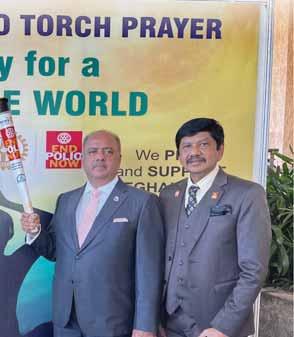
Leaders are like teabags, put them in hot water (pressure) and you’ll know how strong they are. Leaders must not fear challenges.
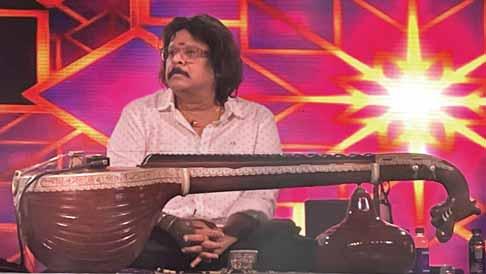
from his pocket he continued, “leaders are like teabags, put them in hot water (pressure) and you’ll know how strong they are. Leaders must not fear challenges.”
Doing good with TRF help
Amegafacelift was given to two government schools in Melur taluk in Madurai, through a global grant project worth ` 41 lakh implemented by RC Madurai Innovators, RID 3000.
Following the renovation of classrooms, compound wall, construction of new toilet blocks and setting up of digital facilities, “the schools have seen a 70 per cent jump in new admissions. With the uplift, more students have been enrolled which will improve the living standard in the nearby villages,” said Rtn P Kumarappan, the project contact.
The delegates at the institute expressed solidarity to Pakistan and Afghanistan in the two countries’ efforts to eradicate polio. End Polio Now chair PDG EK Sagadhevan urged the visitors at a special End Polio booth at the institute to hold a Polio Flame and pray for polio-free Pakistan and Afghanistan so that the world is rid of the deadly virus soon.

DG R Jeyakkan (5th from R), TN minister for school education Anbil Mahesh Poyyamozhi (to the right of the DG), DGE I Jerald and DGN Anandtha Jothi at the inauguration of a school.
In his address at the inaugural ceremony, Tamil Nadu minister for school education Anbil Mahesh Poyyamozhi said, “when the boys study well, it is a boon to the society, whereas if the girls excel, it will be a boon to the entire community.”
The club roped in RC Freshwater Bay, RID 9455, Australia, as its global partner for the school renovation
project which was also supported by the CSR funds of Nataraj Oil Mills and donors Rtns Dr N Senthil Nathan and Dr GM Bharath Kumar. State commercial taxes minister P Moorthy, Madurai district collector Dr S Aneesh Sekhar, DG R Jeyakkan, DGE I Jerald and DGN R Anandtha Jothi appreciated the club for renovating the schools.
Kiran Zehra
It was a pleasant surprise for students and staff at the Government Primary School, Sanjay Nagar, in Uttarakhand when RC Rudrapur, RID 3110, gifted them stationery items, a whole range of books, furniture and other school supplies which were washed away during the massive flood that inundated classrooms and administration buildings. “The school premises went under five-feet
water during the flood. As a result, the record room, furniture and book store were badly damaged. When this was brought to our notice, we decided to surprise the students with gifts that will help them to restart their academic activity,” says club president Vikas Sharma.
A couple of days later, Sharma and his team learned that the rain had also flooded the homes of 107 students from this school. “They lost their
school bags, uniform sets, and study material during the rain.” Moved by the plight of “a student in a battered school uniform, we realised many of these poor students wear their uniforms at home too because they do not have any other clothes. Adding to their misery, the students were also missing school because they had no books and their parents couldn’t afford to buy the school essentials.”
Timely, quick action
In less than a week the club members reached the school with brand new school bags, new NCERT text books, notebooks, stationery supplies and toys, all worth `52,500. “The smiles and happiness on the students’ face when they received the new educational kits, were most satisfying to us,” smiles the club president.
Recalling the trauma the school management

Textbooks being distributed to schoolchildren.
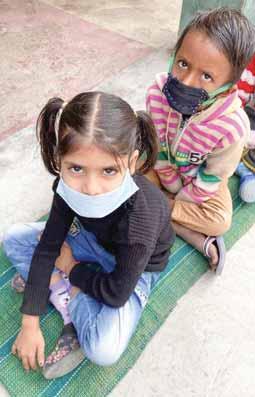
and the students underwent, Chanchlesh Kataria, school principal, says, “Just when the students had returned to school after the lockdown was lifted, the flood hit them hard. Although the stagnant water was
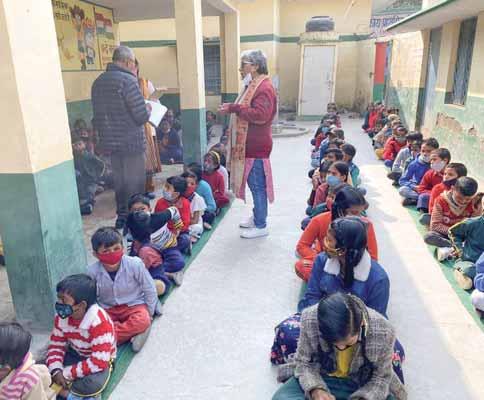
drained and the campus was cleaned, it would have taken us at least six months to get back on track. But the Rotarians surprised us with their generous gifts, and we recovered from the calamity much quicker.”
Beaming with joy, Rashmi, a Class 5 student, says, “My friend and I used to share one pencil and make notes on the papers the teacher gave us. Now we have our own pencils and it will be so much easier to follow the lessons.”

A Rotary Saheli Centre at the Rotary Rudrapur Bhawan empowers women through skill induction. Vocational and personality development training is being imparted to 30 women from nearby villages in the current batch. “The centre has become self-sustaining and those who had completed training refer women from their villages needing a job to this place. The centre helps them earn a regular income through suitable training,” says Sharma. Recently the centre completed an order of 1,000 masks for the Yes Bank and 5,000 masks for a local politician, in the process helping each woman earn `1,000 in a span of five days.
V Muthukumaran
Asmall town in Chitradurga district of Karnataka has turned into a hub for Rotary activities and DG V Thirupathi Naidu, RID 3160, is all praise for RC Hiriyur for helping its people, mostly farmers, small traders and merchants, with a host of service projects including setting up a park, theatre and community hall.
To mark its golden jubilee year, “for the first time, we hosted a two-day district seminar, Sambhrama, attended by 400 Rotarians. We had sessions on membership growth, literacy and public image building in which PDGs Ravi Dhotre, Rajendra Rai, Deepak Shikarpur, Muni Girish, Sreerama Murthy, and Chinnapa Reddy spoke on key issues of Rotary,” says club president H Kiran Kumar. In
the last 50 years, over 600 eye and 300 health check-up camps were held at villages around Hiriyur taluk reaching out to 45,000 beneficiaries who don’t have access to hospitals or medical care, he says. “We have done 10,000 cataract surgeries and our health camps conduct tests for BP, sugar, cancer and heart and kidney ailments.”
Merit awards consisting of a memento and cash prize (`1,000-2,000) are being given to 20–30 school and college students each year. The annual youth seminars for PUC (pre-university course) and college students are quite popular as “we provide interesting sessions on nationality, good citizenry, career-building and leadership skills. So far we have conducted 30 such programmes for the youth in Hiriyur.” At
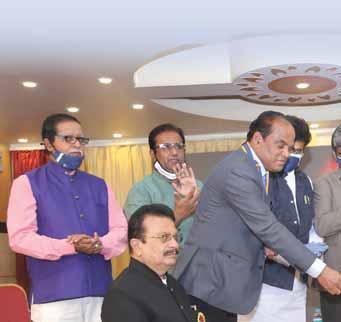
present, five Happy Schools are being done with club funding; and “we have conducted 6–7 teacher training programmes benefitting at least 240 tutors,” says Kumar.
Rotary Bhavana
A grandiose two-storey building with a built-up area of 10,000 sq ft has two meeting halls on the ground floor and a mega event hall on its second floor where social events and community gatherings are held regularly. “The primary building (`30 lakh) was inaugurated in 1997 during the tenure of HS Sundarraj with generous funding by Rotarians, donors and well-wishers. Later on, we added the first floor (`20 lakh) in 2018–19 with Hiriyur legislator Poornima Srinivas donating
From L: PDG R Gopinath, DGN Manik Pawar, DG V Thirupathi Naidu, DGE Satish Vommina, PDG Rajendra Rai, club president Kiran Kumar, RID 3190 DLCC Gurunagesh, AG GA Vishwanath and Event chair H Venkatesh on the dais at the district seminar. Near the dais, from L: District secretary MS Raghavendra and club secretary A Raghavendra.
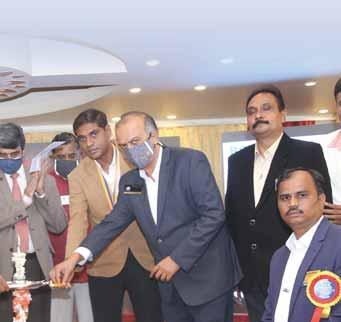


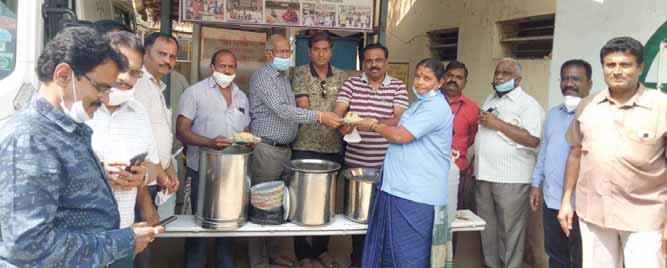
a big sum during the leadership of M S Raghavendra,” he explains.
For large congregations and community festivals, an open air theatre ( ` 13 lakh) was built in 1993 with major donor Sethuram contributing big in memory of his late parents. “The seating arrangement at one end faces an open field and from there, one can see over 2,000 people gathering at this place for religious festivals or social gatherings.” At the city centre, the theatre is a boon to Hiriyur people as it
offers a convenient place to gather and perform on special occasions, he says.
Venkatarathnam sponsored a Rotary park near the Bhavana; while HV Srinivasan, both Rotarians, donated for a children’s library which was later converted into a meeting hall. “If there is a let up in Covid infection, we will hold our district RYLA in February in which we will provide career counselling and leadership training to PUC students. We expect at least 50 youth to participate in it.”
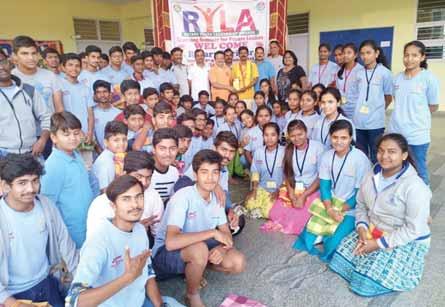
For the first time, the club is applying for a global grant project of installing solar streetlights and lamps at houses (`30–40 lakh) in the next few months. “If the grant materialises, it will benefit over 2,000 houses and 20 villages in Hiriyur taluk. We are guided by DRFC and PDG K Madhuprasad for getting it sanctioned.”
As part of its 50 th year celebrations, the club is distributing 300 freshly-prepared meals to patients and their attendants at the GH, Hiriyur, for two days a week through the year. The project costing `7 lakh is sponsored by G Premkumar, an ex-ward councillor. With 40 members, 35 of them Paul Harris Fellows, Kiran Kumar is keen to induct at least eight new Rotarians by June 30. “Hiriyur is a very small town and the challenge is enormous. During peak Covid times, two Rotarians fell victims, and some have quit our club which had 65 members earlier,” he says. Expressing his gratitude to DG Naidu, he says, “we are following the suggestions given by him to increase our membership. His mentorship helps us to take up grand projects.”

We’ve always heard of Vitamin D as the “Sunshine Vitamin” with the S and V in capital letters. But what we are hearing of late makes you feel it truly deserves its place in the sun. The most recent being: that if you don’t have enough Vitamin D in your body, even the vaccine’s efficacy against the Covid virus and its variants is reduced. That is, in a Vitamin D-deficient system, the vaccine won’t generate a strong enough immune response. That makes you sit up, doesn’t it?
Get out more


The question is: why would anyone be Vitamin D-deficient? There could be two reasons: *Reduced outdoor activities. So, if you’re elderly and mostly at home or are a WFH executive, please ensure to take a walk in the sun and get out more often for groceries and medicines instead of having them delivered at your doorstep. Reminder: Wear your mask and walk on the sunny side of the path.
*The pollution in the air reduces the intensity of our exposure to sunlight. You may have noticed that the sunny effect is marred by smog or fog… even if you just stand at your window and gaze at the scenery… the buildings and mountains in the distance are hazy. It’s unnerving, it wasn’t like that some years ago.
That’s why it shouldn’t come as a surprise that an estimated one billion people world over have D-deficiency.
Bharat and Shalan Savur
We could have D-deficiency if certain symptoms persist. They are: fatigue, bone pain, muscle weakness, muscle aches and cramps. Exercisers need to be aware of these signs persisting postexercise every day, and not dismiss them as ‘exercise-induced aches’ alone.

suggests it should be taken with 200 mcg (micrograms) of Vitamin K2. Research shows that the K-D combination helps the body use calcium the way it should be to build bone and prevents the calcium from being deposited in our arteries and soft tissue and hardening them.

Another symptom is a continuous low current of anxiety and depression. A 2005 study identified that Vitamin D-receptors exist in the same areas of the brain that are associated with depression. Insufficient levels of this nutrient cause inflammation and as a neuroscientist remarked ruefully, ‘It’s as if the brain is asking “Where has all the sunshine gone?”’
According to Dr Joseph Campbell, when we don’t get sufficient sunshine, we need 4,000 to 10,000iu (international units) of a Vitamin D supplement. He
Vitamin D not only strengthens our immune system, it aids our battle against obesity, high blood pressure, colon disease and heart disease. It’s literally a life-saver as higher level of it in our system could protect us from infections and even death.
There’s yet one more healing factor it provides — almost like a messiah performing a miracle. ‘It is,’ says Dr Campbell, ‘a powerful epigenetic regulator.’ Our genes are what we are born with. And our environment and the way we live are the epigenetic factors. So, explains Dr Campbell, ‘Vitamin D turns on our good genes.’ It influences 2,500 genes, and that is almost 12 per
cent of the whole. Updated counts show we have about 21,000 active genes.
It’s very interesting that more and more medical experts are beginning to cognise that human beings and all other species are tropical creatures designed to live in sunshine. Our planet itself is a “sun-planet”, our entire eco-system survives and thrives on sunlight. That’s why it is important to bask, bathe and bloom in the sunny outdoors. During the pandemic, many children developed bow legs. Why? Their little bones did not get sunlight, did not get Vitamin D. When the bones softened, they ‘bowed’ under the weight of the upper body.
Overdosing is impossible
To continue the Sunshine Story, the beautiful, wonder Vitamin D also protects us from cancer, respiratory tract infections, chronic inflammatory diseases, autoimmune disease and multiple sclerosis. And if you get this vitamin from the sun, there is never any danger of overdosing on it. Our beloved D even regulates the innate immune system as well as its adaptive skill. So, when our D3 receptors — the white cells: monocytes and macrophages; members of the immune system: T cells and B cells and the enzyme-endowed Natural Killer cells, as also the Dendritic cells that influence the adaptive skills of our immune system — receive the sun, our body can never produce more than required. Apparently, an unregulated immune system could cause more inflammation if our D didn’t sensibly and efficiently regulate its own production!
Now, the question that pops up is: If I have a Vitamin D deficiency, how long does it take to correct it? Rathish Nair and Arun Maseeh say it ‘can be corrected in four to six weeks by taking 2,000 to 4,000 milligrams daily.’ Of course, it is wise to discuss your dosage first with your doctor. Meanwhile, Dr Deepak Chopra advises us — and no doubt, so will your doctor — to stick with cholecalciferol which is
Vitamin D3 rather than ergocalciferol which is Vitamin D2.
And how much time should we spend in the sun? Anything from 5 to 30 minutes between 7am and 9am or after 5pm in India. This is when the Ultraviolet B rays are strong. After 10am, they tend to be harsh. Applying sunscreen defeats the purpose, that is why the mellow morning sun is recommended. Tips: *Sunning yourself through a glass window is no good. The UVB rays cannot penetrate glass. *Drink enough water so as not to get dehydrated. *If your skin is sensitive, stop before it turns too pink. *If the skin is on the dusky side, expose it for an hour or so, depending on its endurance.
Another natural source of Vitamin D is, of course, our food. Some suggestions: Mushrooms. They provide us with ergosterol which when exposed to UV light converts to vitamin D. The more exposed they are to sunlight, the richer they are in ergosterol. About 100mg of fresh mushrooms — chanterelle, shitake, oyster, button — contain about 100mcg of Vitamin D.
Preparation: Saute them with garlic and salt. Sprinkle salt and push one peppercorn in each and bake. Sister Deepika grinds them into an excellent thick, nourishing soup with salt and celery and tosses in halved pieces of button mushrooms. They make a delicious accompaniment to tomato sandwiches. Friend Deeds rolls out an awesome spinach roti with mushroom and paneer filling.
Egg yolk. Nutritionists say one ego yolk has 35iu of Vitamin D. They advise buying eggs from free ranging farms where hens roam around in the sun and are not caged.
Preparation: Try the classic egg salad or the pan-fried sunny-side-up favourite. It’s great both in Chinese fried rice and Indian spiced rice. Egg muffins and a bread-egg-apple pudding add variety.
Vitamin D not only strengthens our immune system, it aids our battle against obesity, high blood pressure, colon disease and heart disease.
Fish. Favour fatty fish such as salmon, herring, sardines, tuna, pomfret. Approximately 3ounces of fatty fish contain 17.9mcg of Vitamin D.
Preparation: Grilled salmon, fish tacos or delicately steamed pomfret with herbs make a great meal. There are the famous Goan and Mangalorean curries in coconut gravy or the renowned Punjabi fried pomfret which tastes better in a Jai Jawan stall than a fancy restaurant. Cod liver oil. It’s a potent source of Vitamin D. One teaspoon per day provides 113 per cent of the RDA, say nutritionists.
Preparation: It can be just sucked off a teaspoon and chased down with any juice; or mixed in a strongly flavoured smoothie; or blended into a dressing for a salad. The easiest way is to pop a cod liver capsule every morning. Tip: It can even be rubbed into the skin. What it all ultimately boils down to is: getting the sun into you. The sun is our energy just as ‘The trees are our lungs, the rivers our circulation, the air our breath and the earth our body,’ as said so eloquently by Dr Deepak Chopra. Dear readers, please find your own cheerful spot in the sun. Warm the bones, the brain, the heart. Be one with the rustling leaves, the singing birds, the dancing breeze, the endless sky. Stay strong. Stay healthy. Stay sunny.
The writers are authors of Fitness for Life and Simply Spiritual – You Are Naturally Divine and teachers of the Fitness for Life programme.
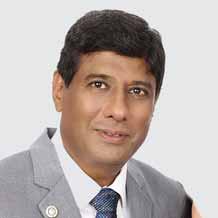
Sunil Phatak
Software & IT training
RC Jabalpur South, RID 3261
Comprising parts of MP, Odisha and the whole of Chhattisgarh, this district poses a big challenge in membership growth as “most of the areas are remote, tribal habitats with the people having no awareness about Rotary,” says Sunil Phatak. But he is hopeful that the GG projects “we are doing will boost our public image, and help us to grow.” His vision is to start 20 new clubs, of which 12 are already formed, to take the strength to 100 by June 30.
He is confident of a net membership growth of 350 this year, taking the total to over 3,300. A dialysis centre (GG: $40,000) with five machines will be set up at the Sindhu Netralaya, Jabalpur. By May, a 50-bed maternity-cum-paediatric ward (GG: $150,000) will come up at the Sri Sathya Sai Sanjeevani Hospital, Raipur, to boost healthcare facilities for mothers and newborns. A Covid testing centre (GG: $40,000) at the Netaji Subhash Chandra Bose GH, Jabalpur, installed last year, “is functioning effectively earning us a good name,” he says. A mobile eye clinic (GG: $35,000) flagged off in January is offering ophthalmic care in remote parts of Odisha.
His target for TRF giving is $100,000. “The annual dues should not be based on the exchange rate, but should be fixed on rupee value. Also, the GST rate of 18 per cent is too high and must be reduced by the government to make the club fee affordable,” he says. Phatak joined Rotary 13 years ago, motivated by his childhood friend Rtn Jitendra Kulkarni.

Chartered accountant
RC Shimoga Midtown, RID 3182
Environment protection is top priority for him and a mega Rotary Biodiversity Forest is being created over an eightacre area in Shimoga. “We have already planted 1,800 saplings and the work is on in full swing,” says Ramachandra Murthy. A GG valued at ` 48 lakh is under process for rejuvenating 12 lakes; and the clubs are sensitising the public on proper, scientific disposal of electronic waste.
He plans to add five more clubs to take their strength to 90 by June-end. “I am targeting a net membership growth of 33 per cent which will raise our headcount to 4,000-plus.”
Eight Happy Schools are on the track; the clubs are donating 2,500 computers to polytechnics and colleges in rural areas in association with Infoys; 22,000 books worth ` 22 lakh were distributed to students under Project Vidya Sethu; and two dialysis centres, one attached to the GH, Balehonnur, with three machines (GG: ` 23 lakh), and the other at the Rotary Blood Bank, Thirthahalli, with two machines, will extend affordable care. “A third dialysis centre (GG: ` 35.5 lakh) will be set up by RC Brahmavara in Udupi shortly.” RC Shimoga Midtown will donate a bus, furniture and computer (GG: ` 30 lakh) to an orphanage. His TRF giving target is $200,000.
Milch cows are being given to 100 rural women (GG: ` 24 lakh). More professionals will join Rotary as service projects are enhancing its public image, says Murthy who joined Rotary in 1992 influenced by PDG Dr Narayana and past president Dr Shivaramakrishna.
V Muthukumaran

Omprakash B Motipawale
Editor/publisher
RC Latur Central, RID 3132
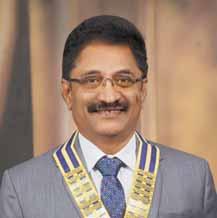
Electrical consultant
RC Coimbatore Midtown, RID 3201
Livestock, bicycles to empower womenSpotlight on ‘Our Lovely Planet’
Aclutch of projects is empowering women and helping them sustain their families with secure income. Already, 300 women were trained in making home-made products such as masala mix, turmeric, chilli powder, pappad and milk-based snacks. “We will train 700 more women through club funding,” says Omprakash Motipawale. Reaching out to those in remote, hill areas, the clubs are providing five goats to each of the 127 families through a global grant. “We have donated livestock to 35 families till now, 92 more will be covered under this project.” In a similar project, 90 milch cows are being given to rural families.
Bicycles will be given to 2,000 schoolgirls in remote areas and a global grant has been sanctioned for the project, says Motipawale. His target is to add 10 new clubs, of which five are already formed, to take the total to 95 by June-end. “We will induct 400 new Rotarians to raise our membership to 4,000-plus. So far, we’ve added 600 new members.”
The clubs have organised three mega artificial limb fitment camps (Jaipur foot, LN-4) and three more camps will be conducted shortly. “We will reach out to at least 1,000 amputees at the prosthetic camps funded by our members,” he says. Around 600 surgeries (hernia, cataract, hysterectomy, hydrocele etc) were done at the mega medical mission in Jalna with the support of the state health department in January. His target for TRF giving is $110,000. A former Rotaractor, Motipawale joined Rotary in 2001 as “being a journalist, I was inspired by Rotary’s activities in the country.”
Under the district priority theme Our Lovely Planet, all the 153 clubs are taking up more than 500 service projects that have positive impact on the Earth, water and humanity through diverse field activities. “I have drafted my primary objectives as ‘Seven wonders of Rotary’ in which our annual goals are listed,” says Rajasekhar Srinivasan. He is starting seven new clubs; forming 70 new Rotaract and Interact clubs; setting up 700 RCCs; raising the membership to 7,000 (he started the year with 5,700); reaching out to 7,000 youth through RYLA, Rotaract etc; providing support to seven lakh farmers; and giving `7 crore ($1 million) to APF as part of TRF contribution of $1.5 million.
Srinivasan was one of the new AKS inductees who were felicitated at the Mahabs 21 institute. “We want to extend all support to farmers as they are being neglected. During the pandemic, they are the ones, apart from the medical fraternity, who toiled the in the fields without a break to ensure that we have food.”
Free breast cancer surgeries (GG: $120,000) will be done in tie-up with the Ganga Hospital, Coimbatore, for women. “We will be renovating the ICU ward ($140,000) at the Coimbatore Medical College Hospital very soon.” At present 68 GG projects are under various stages of implementation and “we have applied for 20 more global grants for the year.” People want to join Rotary as they have seen our projects, he says. He joined Rotary in 2001 inspired by his family friend Rtn Baboo Kannan.
Designed by N Krishnamurthy












There is only one sun and one moon, there can be only one TMS,” said legendary Tamil film music composer MS Viswanathan at an event many years ago.
TM Soundararajan was one of the greatest singers in Tamil cinema history. But he was also the one who struggled the most for recognition. Years of mindnumbing setbacks preceded decades of sensational success.
He was adored by the masses, by humble folk — restaurant workers, cobblers, dhobis, rickshawallahs, potters, plumbers and coolies. TMS was for them the singer of hope.

But he was also hailed by the affluent society. “Whenever and wherever prosperous Tamilians drove fancy cars — not just in India, but in the US, Canada, Singapore, Malaysia, the Middle East — one of the first things they did was to switch on the radio and listen to TMS,” said late Tamil actor Vivek.
“His voice could melt stone, it could make the meek roar, it could make a sinner repent,” remarked a producer.









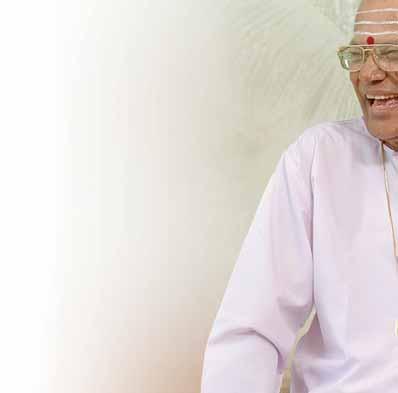
TMS was born in 1923, began his singing career in 1946, lived till the age of 91 and died in 2013. He was active in music industry for six decades, and rendered more than 10,000 songs in a few thousand films, besides some 2,000 devotional songs for many deities including his favourite Lord Muruga. But it was for about 30 years — 1955 till 1985 — that he ruled Tamil cinema. His voice rang out all day from music halls and tea shops, in homes and studios.

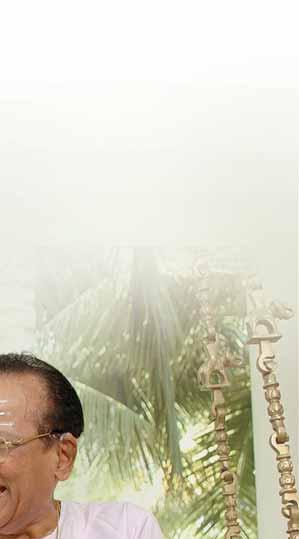
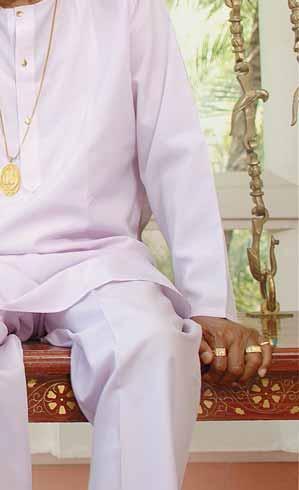

acted as a beggar in one film, where he sang a song. The book of credits for the film said “Pichaikkaran: TM Soundarrajan.”
Whenever and wherever prosperous Tamilians drove fancy cars, one of the first things they did was to switch on the radio and listen to TMS,
He was born in Madurai, son of a smalltime priest who eked out a living through puja and bhajans. TMS was passionate about music at an early age. He memorised and sang whatever music he came across — bhajans, devotional songs, film songs, particularly those of singing star MK Thyagaraja Bhagavathar, the first superstar of Tamil cinema. Bhagavathar songs got him the best rewards — pakora and coffee — which the boy consumed with relish.
His father couldn’t afford to give TMS proper music training, so the boy organised it himself. He did errands
for cinema owners in Madurai and also sang on festive occasions. And they took turns paying `15 a month for his music lessons. His guru was Karaikudi Ramanuja Iyengar: the learning focused on 12 varnams and 48 keerthanas of Carnatic music, which gave him a firm foundation in the art.
However, TMS flopped in studies and failed in the school matric exam. The future seemed uncertain. He didn’t want to be a priest. He joined Central Studios in Coimbatore and did various odd jobs — cleaning, cooking, taking care of children. He even
At the age of 22, already married and with two kids, he left for Chennai with `250 in his pocket and gramophone records of his songs. He found a cheap room in Alwarpet to stay in, located an inexpensive restaurant where he could eat one meal a day. He spent the whole day looking for chances to sing and grabbed any opportunity that came his way.
It was only in 1950, five years later, that TMS got a chance to sing in Tamil films. And only in 1954 that he got his first big break — when he had almost given up hope about his career as a playback singer. Thiruchi Loganathan was to sing eight songs filmed on Sivaji Ganesan in the
film Thookku Thookki. He wanted `500 per song. The producers said, “Why don’t you reduce your rate because you will be singing eight songs?” Loganathan said, “My rate is `500 a song whether I sing one song or eight songs.”
The producers decided to try out the young man from Madurai whom some people were talking about. When TMS was walking on the road, dejected with the unending rebuffs and setbacks, people from Aruna Films stopped him from their car. They said “Are you TMS? We are looking for you”. They tested him, were impressed, and engaged him for a fee of `2,000 for eight songs. TMS was elated. But Sivaji Ganesan was upset. He said “How can you engage a newcomer for me? Why don’t you hire CS Jayaraman

























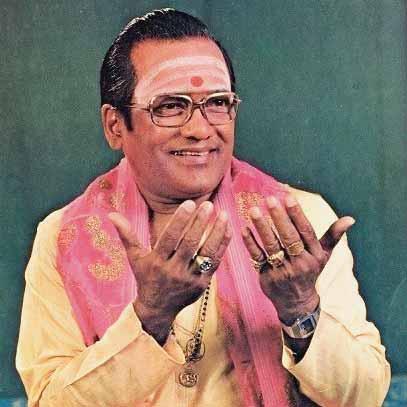
who sang for me in Parasakthi?”
TMS was distraught and crushed. He told Sivaji, “Please try me out. I’ll sing three songs. If you don’t like my singing, I’ll go home and you’ll never see me again.” Sivaji agreed. He was amazed with TMS’s voice and expressive rendering. He told the producers, “Why only three songs, let him sing all the eight songs.”
Thookku Thookki was a massive hit, and its songs are part of music legend. It was one of the first films to star the golden pair of Sivaji Ganesan and Padmini. Three songs in particular — Sundari soundari, Pengalai nambathe and Kurangilirunthu pirandavan manithan — are some of the most lovable songs of the 1950s.


The same year saw the release of Koondukkili, the only film which starred both MGR and Sivaji. A TMS song in
the movie, Konjum Killiyana Pennai charmed MGR, who got TMS to sing a song he considered very important in his landmark movie Malaikkallan. The song: Ethanai kalamdan ematruvai. It showed Bhunamathi on horseback, led by a flamboyant MGR. It became a huge hit, so did the movie Malaikkallan, which was remade in Hindi as Azaad, starring Dilip Kumar.
Thooku Thooki and Malaikkallan made TMS the favourite singer of MGR and
Sivaji, the two tallest Tamil stars. His career skyrocketed. Success followed success.
The person who some months earlier didn’t know where his next meal was coming from, was sought after by one and all. Fancy cars of producers and stars lined up outside his house — ironic, because for years he had known no vehicle other than a rundown bicycle.
For the next few decades, TMS’s power-packed voice mirrored every mood, reflected every rhythm, conveyed every feeling. Songs poured out of



Fancy cars of producers and stars lined up outside his house — ironic, because for years he had known no vehicle other than a rundown bicycle.
this powerhouse — songs of romance, joy, comedy, misery and despair, philosophical reflections, religious devotion, classical ragas, the western beat — reflecting his peerless versatility.
Here’s an anecdote about the calibre of TMS. On one occasion, Sivaji
Ganesan was to enact a song sequence. He listened to a recording of that song by TMS, and left the studio immediately. The worried producer asked Sivaji what happened. Said Sivaji: “TMS hasn’t just sung the song, he has enacted it with his voice, and done it so well. I must
now ponder about what I can do as an actor to add value to the song.”
Many memorable scenes in Tamil movies are based on TMS songs which are etched in everyone’s memory. For example: Thoongathe, thambi, thoongathe — Nadodi Mannan, 1958 “Don’t sleep, brother, don’t sleep”, prisoner MGR tells jail guards. The song’s subliminal message for the masses was that MGR worshipped work and detested sloth. A popular song one always associates with both MGR and TMS.

TMS with lyricist Vairamuthu and playback singer P Susheela.


Vanda naal mudhal, indha naal varai — Pava Mannippu, 1961

Sivaji cycles as TMS sings “Over millenia, the oceans, the skies, the trees, the earth have not changed, only man has changed.” The song is a triumph for scriptwriter Kannadasan, singer TMS and actor Sivaji.
Acham enbathu madamaiyada — Mannadhi Mannan, 1961
Full of spectacle, fights, music, dance and romance, this film begins with MGR riding a chariot proclaiming “Fear is folly”. Fans of TMS asserted that “his voice embodies and inspires fearlessness”.
Chithiram pesudadi — Sabaash Meena, 1965
Sivaji in the alluring voice of TMS lauds his pretty sweetheart Malini in front of her portrait; the Malini of flesh and blood hides behind a curtain and enjoys his praise. Winsome visuals, captivating melody.
Masculine voice and impeccable Tamil What made TMS a stand-out singer? Lyricist Vairamuthu mentions two attributes: his masculine voice and his impeccable Tamil. “To teach my children
























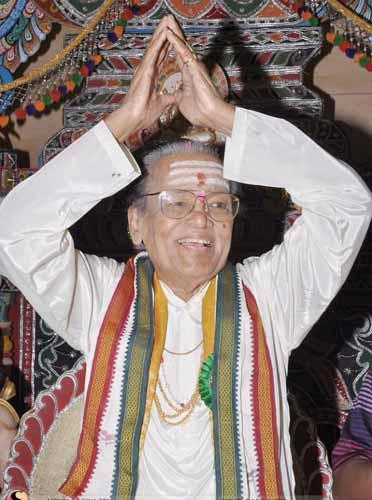
Tamil, I made them listen to TMS. His pronunciation, the way he uttered every syllable, was perfect.”
The masculinity in TMS’s voice was shaped and honed by composer G Ramanathan, says Vairamuthu. TMS himself has credited Ramanathan for the “lion in his voice”. TMS also owed much to composer MS Viswanathan; “he introduced TMS to the western beat, and made his voice more modern,” says Vairamuthu.
Several of TMS’s songs for Sivaji exemplified the power of his masculine voice as well as the majesty of
the Tamil language and the appeal of classical ragas. Example: the iconic Pattum naane, bhavamum naane, sung splendidly by TMS, and filmed on Sivaji in a royal court in Thiruvailaiydal.
As for MGR, TMS’s powerful voice was an asset for the leader’s political ambitions. An example is the celebrated song Naan Aanaiyittal (Enga Veetu Pillai), in which MGR berates the villains of society and thunders “I’ll never forgive those who ill-treat the poor.” The audience roars its approval — of the hero, even more so of the real-life MGR.
Fans of TMS asserted that his voice embodies and inspires fearlessness.
Vairamuthu says a big plus point of TMS was the way he modulated his voice while singing for any actor, after studying the actor’s speech and voice patterns. His techniques for a song on Sivaji and a song on MGR, for example, were different. Sivaji had a deep stentorian voice, MGR spoke softer.
Says actor Vivek, “A blind man who heard a TMS song would be able to say for which actor he was singing — Sivaji, MGR, Gemini Ganesh, Muthuraman, Jaishankar or Ravichandran.”
During the 1980s and later, TMS performed many live music shows abroad to enthusiastic full houses. His 60th year as singer in 2006 spurred a spectacular celebration in Madurai led by then Chief Minister M Karunanidhi. Artists young and old hailed the quintessential Tamil singer as the uncrowned king of Tamil film music. He passed away seven years later.
The author is a senior journalist and a member of the Rotary Club of Madras South
Designed by Krishnapratheesh S
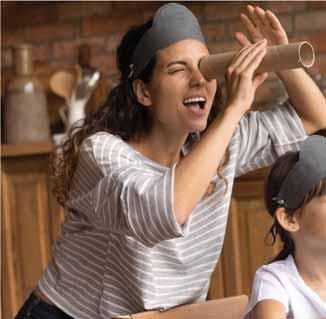









For many, London throbs with exciting shopping opportunities; it is also a living repository of history. Along comes a book that presents a side of London few know or even care about.
This Is London by Ben Judah was longlisted for the Baillie Gifford prize for nonfiction in 2016. This award is touted as the UK’s premier honour for a work of nonfiction, and for those who enjoy nonfiction, a visit to its website is a must. The 2021 winner was Patrick Radden Keefe’s The Empire of Pain: The Secret History of the Sackler Dynasty. The Sackler name, apparently, ‘adorns the walls of many storied institutions — Harvard, the Metropolitan Museum of Art, Oxford, the Louvre. They are one of the richest families in the world, known for their lavish donations
to the arts and the sciences. The source of the family fortune was vague, however, until it emerged that the Sacklers were responsible for making and marketing a blockbuster painkiller that was the catalyst for the opioid crisis.’
Previous winners include East West Street by Phillipe Sands, How to Survive a Plague by David France, Chernobyl by Serhil Plokhy, The Five: The Untold Lives of Women Killed by Jack the Ripper by Hallie Rubenhold, and One Two Three Four: The Beatles in Time by Craig Brown. But it’s not just the winning titles that will hook you, the longlists in themselves are a library of amazing reading that will engage you for years!
and nightclubs to the frontlines of its streets, Judah has supped with oligarchs and spent nights sleeping rough, worked on building sites and talked business with prostitutes; he’s heard stories of heart-breaking failure, but also witnessed extraordinary acts of compassion. … This is London explodes fossilized myths and offers a portrait of what it’s like to live, work, fall in love, raise children, grow old and die in London now.’

Judah’s London reaches out to us in the voices of Arabs, Afghans, Nigerians, Poles, Romanians, Russians and others. As the Baillie Gifford citation describes it: ‘This is the new London: an immigrant city. Over one-third of Londoners were born abroad, with half arriving since the millennium. This has utterly transformed the capital, for better and for worse. … Ben Judah is an acclaimed foreign correspondent, but here he turns his reporter’s gaze on home, immersing himself in the hidden world of London’s immigrants to reveal the city in the eyes of its beggars, bankers, coppers, gangsters, carers and witchdoctors. From the backrooms of its mosques, Tube tunnels
Just back from a visit to this most engaging of cities, I instantly connect with these words. I’ve met an Albanian cleaner, a Bolivian waiter, and seen the work of a Lithuanian house painter. Whichever way you turn, you see its rainbow-coloured hues. At Thai Taste restaurant in Kensington, a young man from Rwanda waits our table. At the Cos showroom in Westfield mall, a charming woman from Bangladesh finds exactly the right woollens for us. And when we thank the distinctly un-white young man at the checkout for the friendly service, he smiles and speaks proudly of their multicultural profile. In M&S we bump into ‘Divya’ who checks her stocklist to answer

I’ve come to London to fiddle and beg. They told me these were the richest streets in the whole world.



our queries regarding the availability of a certain style of jacket; we discover that she has lived in Nungambakkam, Chennai! And in a neighbourhood shop where we go to get colour printouts of documents for the return travel, we meet two helpful brothers of Pakistani origin who patiently attend to all our technologically-challenged needs. Everywhere you are made aware that population of London is no longer ‘English-Vinglish’, and statistics reinforce this perception. However, that’s just one flavour emanating from this salad bowl. Judah’s stories are not about those who have assimilated or become true-blue Londoners. It’s about those on or outside the fringes of society, both economically and socially. It’s a narrative the author conveys in direct but compelling prose, often in the lingo of his subjects. Sometimes it seems overstated, but we know that in life, we actually never know.


The best way to listen to these stories, then, is by accepting that they need to be told repeatedly. Take the Romanian outside Lanesborough Hotel, for instance, fiddling scratchily on a violin, confessing, ‘I’ve come to London to fiddle and beg’. The crops in his northern
Romanian village had sold for nothing, his fridge was empty, his children were weeping and the loan sharks didn’t care for him. ‘They told me these were the richest streets in the whole world,’ he tells Judah. ‘You’ll never get anything about what it is to be a beggar until you’ve slept on the streets.’ And that’s exactly what the author sets out to do in order to understand migrant lives from the inside out. Blake Morrison points out in a review in The Guardian: ‘Some of what he uncovers makes for dispiriting reading: the fierceness with which each ethnic group sticks to its own enclave; the drug wars and protection rackets; the speed at which the inner city is being socially cleansed and “old immigrant London” pushed out to the fringes. But the book is reportage, not a moral tract; Judah wants to tell it like it is, with I-am-a-webcam neutrality, not preach or harangue. He hears things being said and, even if they are paranoid or semi-literate, faithfully sets them down: “Look what’s happening in London, mate … Zone 1’s being sold to the Russians and Zone 2’s being bought by the poshos.” “You know what shock me about the London. That you on your own. People not friendly … Some bad men come and mug you … and they will walk

right past you.” “You want the same fucking Mo Farah* wonder story … well, let me tell you what, you’re ain’t gonna find it.” (*Mohamed Muktar Jama Farah is a Somali-born long distance runner, and Britain’s most successful track athlete in modern Olympics history.)
Judah seems to have a knack for getting people to share their stories: the policeman of Nigerian origin who like countless others slipped into England seeking a better life which translated into doing odd jobs in restaurants, cleaning trains and finally being recruited into the police force. Or Moses whose life as a teenager was ruled by drugs and trafficking, or the Filipina housemaid or the imam… Margarita, a cleaner from Poland, who boasts she knows everything about the homeowners. ‘I know a lot. I know that the woman I am cleaning in the Clapham, she cheats, because I clean the sheets. I know the banker who I clean in Clerkenwell, he is taking the cocaine, because I find the Oyster card with the powders on the table.’ We get a glimpse into the kind of work migrants do and we read about what migrants think about the British: rude, snobbish, entitled, lazy. Still, they pin their hopes on London the city and the possibility of survival government policies enable.

The best thing about the book is that Judah or Judah’s voice pops up only occasionally; most of the time it’s the migrants’ voices you hear, their eyes you see through. It’s social history writing that gets as good as it can get, though, clearly, no record of any kind of history can be entirely unbiased. Keep this in mind and there’s no doubt this book with ‘the stories you never hear, the people you never see’ will compel you to empathise with the world it describes.
The columnist is a children’s writer and senior journalist

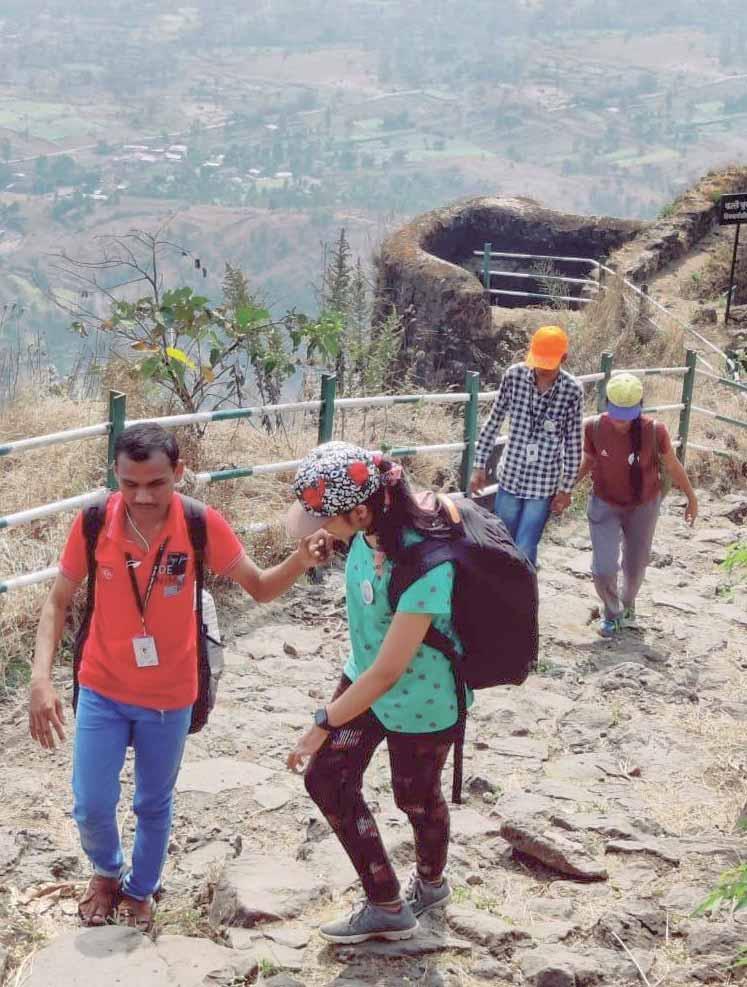

Giving shape to the aspirations of the visuallychallenged, a new Rotaract club was chartered exclusively for them in Pune. All its 26 members are students of Sir Parashurambhau College, Pune. “The new Rotaractors at RAC Divya Zhep, of which two are physically-challenged, are talented and have big dreams. The Rotaract platform will not just enhance the leadership skills in these students but, also make them part of an international community,” said Vinay Patil, president, RC Pune East which has sponsored this one-of-itskind Rotaract club.
The Rotaractors will be given job-specific training based on their physical limitations and once they complete their graduation, “they will get employed and be able to support themselves economically,” said Patil. He added that sightless people face many social hurdles and the workplace is not friendly to them.
Samruddhi Bhalwankar, president of RAC Divya Zhep, is a poet, storyteller, writer and debater with a score of 88 per cent in language and arts in her second year of college. She has cerebral palsy by birth and is paralysed on the left side of the body. “But that doesn’t define me or will stand in the way of my dream to go

to Germany and become a Sanskrit teacher,” she says confidently. She is excited about her Rotaract journey and is “looking forward to meeting new people, participating in meaningful activities and learning new skills that will help me build a secure future.”
During the induction ceremony in November 2021, the Rotaractors were gifted a white cane by the parent Rotary club. “It’s a meaningful gift,” says Rtr Yowraj Dalve, the club secretary. He recalls a time “when I thought that a white cane was a symbol of shame and failure. But now it has become the best tool for me to walk beside those with sight and become more comfortable being alone. Using the cane makes me feel powerful and in control,” he said.
The new Rotaract club is named after a group that arranges writers for the visually and physically-challenged students during examinations at this college. The group has also started a library on the campus where volunteers read books to blind students who can also use the reading and listening software installed in the library computers, or read Braille books. “We wanted to give the disabled students an equal chance to participate in all the activities in the college. The objective is neither pity nor sympathy, but to treat them equally, understand their needs at a personal level and in certain cases learn from them,” says Prof Yogita Kale from the Arts department, and founder of the group. She
is also the mentor for the new Rotaract club.
The Divya Zhep group organises trips and treks to various forts around Pune for its members. So, is it tough for them to climb? “Yes, but they want to experience their history lessons, especially stories about Chhatrapati Shivaji Maharaj. They touch the giant doors, feel the surface, lie down on the floor of the fort and want to know how large the room is,” she says. Sometimes the group mentor narrates the stories again at the fort and they love it.
These special Rotaractors are trained in dance and also perform street plays on various social issues like road safety and hygiene. “With the help of RC Pune East, we are sure our student Rotaractors will be able to do and achieve more,” Yogita adds.


Preeti Mehra

As far as environment protection goes you are literally what you wear. This is true of a world where influencers urge you to weardiscard-and-buy as frequently as you can. Indeed, ‘fast fashion’ may be the
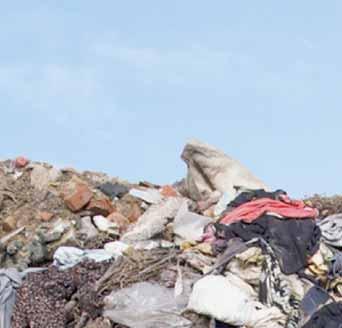

It’s time to change to a ‘green’ dress code.

buzzword for the smart set but for the environment it is like a death knell.
As things stand, the textile industry contributes around 10 per cent of global carbon emissions, which is more than all the international flights and maritime shipping put together! So, what can we do to limit this damage? No, you needn’t say goodbye to clothes, but you can be choosy about
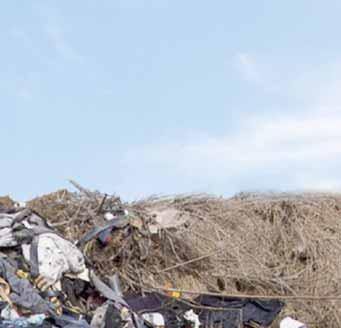
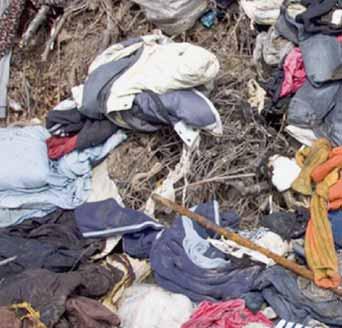
what you wear and how many clothes you pack into your wardrobe.
In recent times, fast fashion — inexpensive clothing produced by mass-market retailers in response to the latest trends which keep changing by the minute — has been identified as the main culprit causing a worldwide clothes explosion. In the last 20 years clothing production has more than



doubled, touching 100 billion items of clothing per year. A mind boggling 85 per cent of these end up in landfills because they are cheap, of indifferent quality and quickly disposable. It is estimated that with every passing second the equivalent of one garbage truck of textiles is landfilled or burnt.
As environment conscious citizen we must curb our urge, as well as that of our children, to order online to be mindlessly trendy. It is estimated that the number of times a garment is worn has declined by 36 per cent in 15 years. Several people have extended arguments in favour of the fast fashion industry — that it creates jobs, helps textile workers, gives consumers many more choices and keeps the economy buoyant. Several companies have announced how they have shifted to eco-friendly packaging of the clothes they ship. But these arguments don’t pass muster.
results. A few cities have already begun lending libraries for clothes where one can rent a garment for a party, wedding, or any special occasion.
The third argument is of ecofriendly packaging, well that’s the least any company selling products can do. But that is not enough and cannot in any stretch of the word be called ‘sustainable fashion’. A pertinent point to take note in this context is that a green package may contain clothes that are by no stretch eco-friendly!

For instance, we know that textile workers hardly get a minuscule fraction of the money a consumer pays to buy a dress. Most of them do not even have benefits such as provident fund, gratuity, or a health allowance. In fact, almost 90 per cent of the textile workforce comprises women and a majority of them live in poverty. This is even as the fashion industry, with all its fancy brands, profits in crores and ignores norms and laws of just production and business practices.

So, then what exactly is ‘sustainable fashion’ that we need to support and opt for? It starts from the seed itself and the way cotton is grown to how it is woven into fabric. It also includes the treatment meted out to animals sheared for their wool, and the wages and working conditions of workers. Remember, the infamous sweater shops operating in our part of the globe? These too make garments far from sustainable.

And though fast fashion may enhance consumer choice, there are other ways of achieving the same It is estimated that the number of times a garment is worn has declined by 36 per cent in 15 years.
It takes 2,700 litres of water to produce the t-shirt and 7,571 litres to produce a pair of jeans. Just washing clothes releases half a million tonnes of microfibres into the ocean every year.

Take for instance, the t-shirt and jeans you often wear. According to estimates it takes 2,700 litres of water to produce the t-shirt and 7,571 litres to produce a pair of jeans. In fact, the fashion industry generates 20 per cent of global wastewater. Just washing clothes releases half a million tonnes of microfibres into the ocean every year. The prognosis is this: if nothing is done about it, then by 2050 the fashion industry will use up a quarter of the world’s carbon budget.
Discerning consumers are now moving towards garments of organic cotton. The plant uses almost 91 per cent less water, reduces carbon dioxide emissions by 45 per cent and there are no pesticides used in its growth. Of course, organic cotton is far more expensive and does not appeal to those in need of cheaper clothes. But the green argument is that it is better to have fewer good quality garments that last years, instead of
less expensive ones that one would discard rapidly.
While we can discuss in detail in the next column how with innovation you can turn your wardrobe green over time, when it comes to buying clothes online or from branded stores, here are a few tips: Choose brands that are known to be ethical and those that have signed the 2018 Fashion Industry Charter for Climate Action to help reduce the sector’s impact on global warming. And you will be happy to know that a lot of your favourite brands have opted for the charter, including Adidas, Decathlon, Gap Inc, H&M, Kmart, Levi Strauss, Nike, Otto, Puma, and some others.
There are some small and ethical companies too who are using organic, going in for sustainable and ethical practices, and waiting for the conscious customer.

By choosing sustainable brands that provide good quality garments, take back old ones for recycling, manufacture products from recycled material, and strategise to reduce CO2 emissions, you will reduce your own waste and save your money as well.

The writer is a senior journalist who writes on environmental issues
Designed by N Krishnamurthy

Highest Membership GrowthRajesh Agarwal (RID 3054)S Muthu Palaniappan (RID 3232)
Highest Membership Growth %Gajendra Singh Narang (RID 3040)S Muthu Palaniappan (RID 3232)
Highest Women Membership GrowthRajesh Agarwal (RID 3054)PNB Murugadoss (RID 3212)
Highest Number of New Rotaract Clubs InstalledRamesh Bajaj (RID 3080)S Muthu Palaniappan (RID 3232)
Highest Existing Membership Retention Growth %Harish Kumar Gaur (RID 3053)Ajith Weerasinghe (RID 3220)
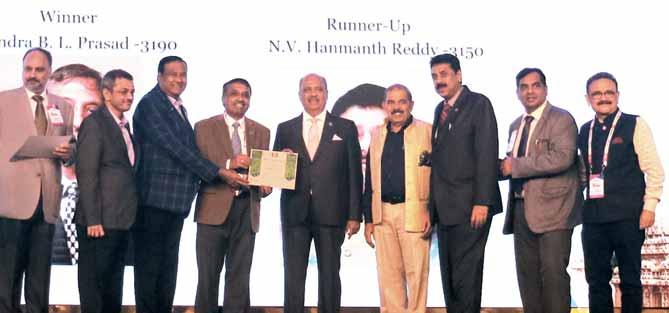
Clockwise from above: RI President Shekhar Mehta honours RID 3190 PDG Nagendra Prasad for membership growth. Also seen (from L) RC Gurjeet Singh Sekhon, PRID Bharat Pandya, PDG Ravi Dhotre, DG Fazal Mahmood, PDG Sameer Hariani and DGE Jeetendra Aneja. PRID Pandya and Madhavi felicitate IPDG Shabbir Shakir and his wife Jumana in the presence of PDGs Rajiv Sharma, Sangram Singh Bhonsle, Kishor Kedia, Anirudha Roy Chowdhury, Dr K Sunder Rajan and Mahesh Mokalkar PRID Pandya and Madhavi present an award to IPDG Dr Hari Krishnan Nambiar and his wife Dr Smitha in the presence of RPIC VG Nayanar. RI President Mehta presents an award to PDG Ramesh Bajaj and Rekha in the presence of RID AS Venkatesh (R). IPDG Sudip Mukherjee receives an award from RI President Mehta in the presence of PDG Pradeep Mukherjee (R). and PRID Pandya gives a public image award to IPDG B Rajarama Bhat and his wife Varadhamba in the presence of Madhavi Pandya, Usha and PDG BN Ramesh.


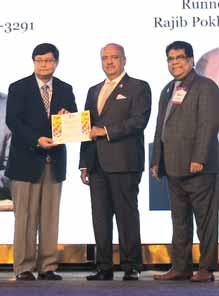
Highest Membership GrowthRajib Pokhrel (RID 3292)Nagendra B L Prasad (RID 3190)
Highest Membership Growth %Rajib Pokhrel (RID 3292)Nagendra B L Prasad (RID 3190)
Highest Women Membership GrowthRajib Pokhrel (RID 3292)Nagendra B L Prasad (RID 3190)
Highest Number of New Rotaract Clubs InstalledSudip Mukherjee (RID 3291)N V Hanmanth Reddy (RID 3150)
Highest Existing Membership Retention Growth %Karunesh Srivastava (RID 3120)N V Hanmanth Reddy (RID 3150)
Social Media
Print Media
Audio/Visual
Gajendra Singh Narang (RID 3040)
C A Davinder Singh (RID 3070)
C A Davinder Singh (RID 3070)
Special Event for PIPrashant Jani
Overall activities
C A Davinder Singh (RID 3070)
Jose Chacko Madhavaserry (RID 3201)
Harikrishnan Nambiar (RID 3202)
K S Venkatesan (RID 2982)
R Balaji Babu (RID 2981)
R Balaji Babu (RID 2981)
Subhasish Chatterjee (RID 3240)
Rajib Pokhrel (RID 3292)
Karunesh Kumar Srivastava (RID 3120)
Rajan Gandotra (RID 3250)
Shabbir Shakir (RID 3030)
B L Nagendra Prasad (RID 3190)
Sangram Patil (RID 3170)
Rashmi Kulkarni (RID 3131)
B Rajaram Bhat (RID 3182)

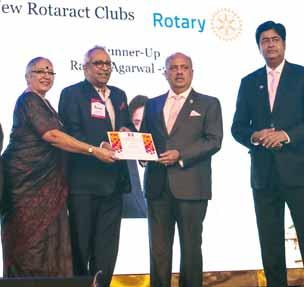
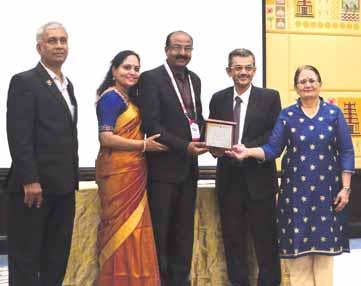
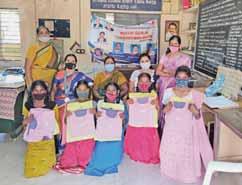
Uniform sets were given to students at the Government
Girls Higher Secondary School.
A signature campaign was launched to make Faridabad cleaner and greener. Members took an oath of cleanliness at the club’s Sharad Utsav, a family picnic.
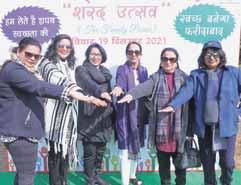
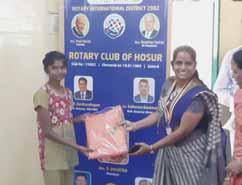

New dresses were distributed to 100 girl children at the Indira Gandhi Home for Girls on Diwali at Madhagonda palli village.
Club president S Jeevitha presided over the event.
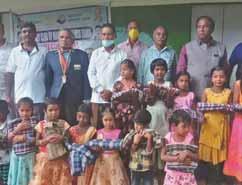
Children’s Day was celebrated at the UOT School in Thirumane Lake area with students performing a variety show. Club president C Kurusami interacted with the students.
Around 100 people were screened for cancer at a health check-up camp, held in association with the Indian Cancer Society, at the Max Height Society. A cancer patient was adopted by the club.
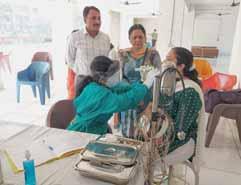
Club president Dr Arun Pathade felicitated RI President Shekhar Mehta at the district seminar in Amravati. DG Ramesh Meher, AG Dilip Thakare and PDG Kishor Kedia were also present.
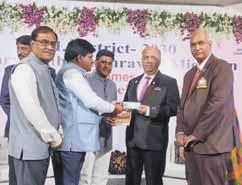
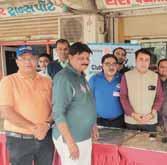

Over 240 people were examined for ailments by project chair Dr Shailesh Patel and co-chair Dr Nikunj Patel at a week-long medical camp held in partnership with the Yash Pathology Lab.
Over 100 people took the blood sugar test at the Nehru Nagar Park. This was followed by a session addressed by Dr Tarun Singhal on diabetes.
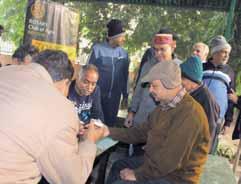
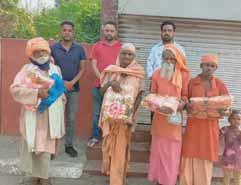
Blankets were given to destitute and elderly people at the Phagwara railway station to protect them against wintery nights.
A diabetes camp organised in association with RC Pune Tilak Road and Sinsan Pharmaceuticals at Gandhinagar, Yerwada, benefitted 80 patients.


Pencils made from paper waste were distributed to students at the Atmaram Kumar Sabha School and Shakuntala Girls School, Patiala. AG Rajeev Goyal organised the project in the presence of district secretary Rajiv Mittal.
The club renovated an anganwadi in Belpandhari village in Newasa taluk. DG Omprakash Motipawale and district literacy chair Sanjay Ghule were present.


Meals were distributed to 300 children, teachers and residents at Aina village in Palghar district. A computer lab was inaugurated.
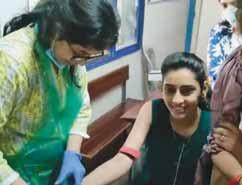
A thalassaemia awareness and check-up camp was held with the support of Rotaractors at the Bharat College. Around 120 students benefited.
A dental check-up camp was held at the Shushruta Hospital, Hubbali, for 39 Interactors at the Rotary School Bengeri.
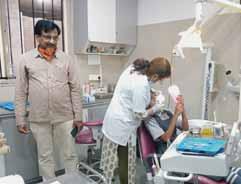

Uniforms were distributed to girl students at the Veena Sharada High School, Shimoga. Club president and other members were present.
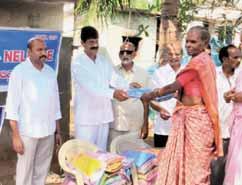

Sarees were distributed to flood-hit families at Gangapatnam, Srinivasapuram, Moolapadu and Mudivarthipalem villages in Indukurupeta mandal of Nellore district.
A mega signage on End Polio Now was installed at an inter-state border to create awareness among commuters on the efforts by Rotary to eradicate the disease.

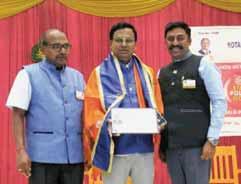
An End Polio Now event was held with the participation of 200 Rotarians and Rotaractors to create awareness on Rotary’s efforts to wipe out the disease from the earth. Club secretary Kanthavel donated `1 lakh for Polio Fund.
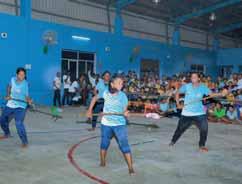
A state-level Silambam (traditional sport) competition was held jointly with the AAA International School and Lee Martial Arts Sports Academy.
Club president A Vijayakumar presided over the event.
Raghav Singh (Class 11) from Delhi Public School, Noida, emerged winner at an online pan-India science and tech solo quiz hosted by the club. Around 3,000 students took part.
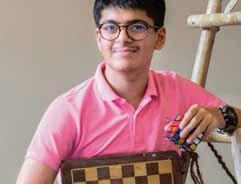
RC Sivakasi Greens — RID 3212RC Jagdalpur — RID 3261 RC Vellore North — RID
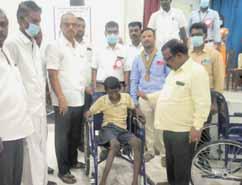
Wheelchairs were donated at the SIH-R and LC Hospital, Kairigiri in Katpadi. Club president Loganathan and AG Arumugam were present.
In a bid to create awareness on eye donation, the club organised a walkathon in which the participants including celebrities walked blindfolded to feel the life of visually-impaired.

Rotary Medica Wellness cards were distributed to Rotarians, Rotaractors and their families, in partnership with RC Calcutta and the Medica Super Specialty Hospital.
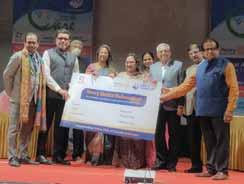
Compiled by V Muthukumaran
Let me apologise to the readers at the very outset for the angry tone of this article. But the truth is that I am angry. Anyone would be at the sheer callousness of our successive governments since the late 1950s. Let me explain. All my life I have lived in North India, or more accurately, Delhi. Until the late 1990s, the sky here was blue. But since then, it has become browner by the year. When you fly into Delhi you start descending into the brown cloud of dust and manmade particles when you are as high as 20,000 feet. Gradually the ground below becomes hazy and almost disappears by the time you are at 5,000 ft. It’s this filthy air we now breathe day in and day out. In fact, we had nearly forgotten what clean air is like until the lockdown of April 2020.
Then, suddenly, the sky over Delhi and the National Capital Region became like it used to be, clear and blue. In fact, even during October and November 2020, despite the stubble burning, the air remained clean and the sky blue. Then, as the lockdown was gradually lifted, the brown smog returned. By April we were back where we started. It remains that way.
It has become obvious to everyone that vehicular movement is largely responsible for the NCR’s dirty air. The Air Quality Index for PMI 2.5, the particles that injure your lungs the most but are invisible, rarely comes
down below 325 and usually stays between 350 and 400. And, just as people in the West check every morning to see if it will rain, people here check to see how bad the air is. And if it’s below 350 they feel relieved. I am sure all our lungs are brown or even black by now, as if every man, woman and child has been a chain smoker since he or she was born.
Verily, North India, in the circle from Amritsar to Lucknow is a gas chamber. Around 300 million people, or the entire population of the US, live here and breathe this air. The tragedy is that while an antidote to the coronavirus has been found, there is zero effort being made to reduce vehicular pollution even though it

affects everyone living here, that too all 12 months of the year. No mask is good enough. Social distancing is irrelevant.
And unlike the virus induced pandemic, things are only going to get worse because the government will not do the obvious thing — disperse the offices. Instead, it is busy concentrating more offices in Delhi. So what we get from stubble burning for 45 days every year during October and November, we get for 365 days because of office and business concentration and the vast vehicular movements this causes, along with an entirely unnecessary degree of construction that goes on all the time, everywhere.
When you fly into Delhi you start descending into the brown cloud of dust when you’re as high as 20,000 feet. Gradually the ground below becomes hazy and almost disappears by the time you are at 5,000 ft.
In 2011 the population of the city of Delhi alone was 1.6 crore. In 2021 it was over 2 crore. If you take the NCR as a whole which you must because people drive around in it all the time, we are talking of around 3 crore people. As to the number of vehicles, Delhi alone has around one crore. Add another 20 lakh or so for the NCR and a daily truck movement of around 200,000 that pass through the region. That’s when you begin to get a measure of the sheer enormity of the pollution problem.
So what’s the solution: over the next ten years move all, except the home, defence, finance and external affairs ministries, out of the NCR to towns with smaller populations. Their facilities will improve and the NCR’s pollution will abate.

Poet, writer and activist Maya Angelou has become the first black woman to appear on a US quarter dollar coin. The US Mint released a coin featuring her which was created as part of the American Women Quarters Programme to honour remarkable women of US. Artist Emily Damstra has designed the coin using a reference from Angelou’s memoir I Know Why the Caged Bird Sings (1969).

Maharashtra Governor Bhagat Singh Koshyari honoured PDG Deepak
Shikarpur for his contribution to the growth of software industry in the state. In the last two years, his career-counselling portal (www.itcareercounselling.com) has helped hundreds of aspiring IT professionals and students to upgrade their skills and establish a bright career. Shikarpur has authored 43 books on IT and is currently serving as the Rotary public image coordinator of Zone VII.

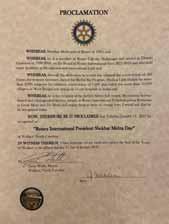
After his address at the Rotary District 7730 annual Foundation Banquet, in Wallace, North Carolina, USA, RI President Shekhar Mehta was in for a sweet surprise when Jason Wells, mayor of Wallace, announced that Jan 11, 2022 will be recognised as Rotary International President Shekhar Mehta Day. The proclamation was handed to Mehta who said, “It was a humbling experience.”
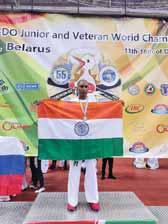
Dr M Sreenivas from RC Bangalore South, RID 3190, won a gold medal for individual sparring, a combat sport under the 50–59 veteran category at the 55th Veteran World Championship held at Minsk. Sreenivas is a Dan Black belt holder and had been training for this event for 12 years.
Kumbalanghi, a village in Kerala that has been acclaimed as India’s first model tourism village, is set to become the first sanitary napkin-free village in the country. The move is a part of an initiative named Avalkayi (For her), being implemented by Ernakulam MP Hibi Eden. Over 5,000 menstrual cups will be distributed to women aged 18 and above in the village.
Compiled by Kiran Zehra; Designed by Krishnapratheesh S
Registered No. TN/CCN/360/2021-2023
Licensed to post WPP No.TN/PMG(CCR)/WPP 431/21-23
Total number of pages in this monthly issue, including cover, 84. Price: `35
Registered with Registrar of News Papers for India 3880/57 Rotary News Published on the first week of every month
For several years, Rotary clubs not subscribing to a Rotary magazine or not paying magazine dues have frustrated the regional magazine managers. Non-subscription has a direct impact on sharing Rotary’s core messages.
After the RI Communications Committee’s deliberations on non-compliant clubs, at its November Board meet, RI has updated its rules for non-compliant clubs, which could now face termination. Existing rules and new ones:
Previous Process
The magazine office sends a report of non-compliant clubs to Rotary International.
Template letters from the district secretariat are shared with the magazine office, which then sends the letter to the appropriate clubs.
The club has 120 days to comply or be suspended.
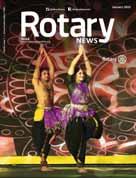
New Process beginning July 1, 2022
The magazine sends a report of non-compliant clubs to RI, clarifying if they are non-compliant due to non-payment - OR - not subscribing at all. Reports should be sent quarterly.
The magazine sends the letter to the clubs; Rotary will notify the District Governor with a separate letter.
The club has 90 days to comply or be suspended. If the club does not comply, the magazine sends a report to RI. Clubs are suspended.
Two weeks before the 90-day grace period, another reminder is sent to clubs still non-compliant. If the club does not comply, the magazine sends a report to RI. Clubs are suspended.
Process ended here.
For clubs that stay suspended and non-compliant for 180 days, another letter is to be sent stating “the Board at its discretion can terminate the club.”
Monitor club.
PETS & GETS curriculums will include information about mandatory subscriptions.
A threshold defining non-compliance will be determined: either 20% or 50% of club members?
Since this process will now be included in the Rotary Code of Policies, we hope to see better compliance. The Board of Directors to advocate for magazines in their zones. Directors were surprised to learn of the non-compliance of clubs, and that there are district governors and club presidents who are not aware of the mandatory subscription. That means Rotary must increase the messaging on mandatory subscriptions at PETS and GETS.
(For the information of our readers, the German regional magazine is delivered to over 65,000 Rotarians — almost 99 per cent of the total number. The rest subscribe to Rotary. In Japan, of the 85,000 members, 99 per cent subscribe to RotaryNo-Tomo; the remaining one per cent and many other Rotarians, subscribe to Rotary. In Switzerland and Liechtenstein — with 13,200 Rotarians in total — there’s only one club that doesn’t want to subscribe to any Rotary magazine. The local DGs are now solving that problem.)
Rotary News urges Rotary clubs in our zones to pay their subscription dues diligently.